Myanmar, a country located in Southeast Asia, is home to a wide variety of birds. With its diverse landscape, Myanmar houses birds from a variety of habitats, including tropical forests, mangroves, wetlands, and highlands.
Many of the birds found in Myanmar are endemic, meaning they are found nowhere else in the world. This makes Myanmar an important place for bird conservation, as many of its species are threatened by deforestation and other environmental issues.
In this article, we will explore the many birds of Myanmar, their habitats, and the conservation efforts being made to protect them.
1. Great Hornbill
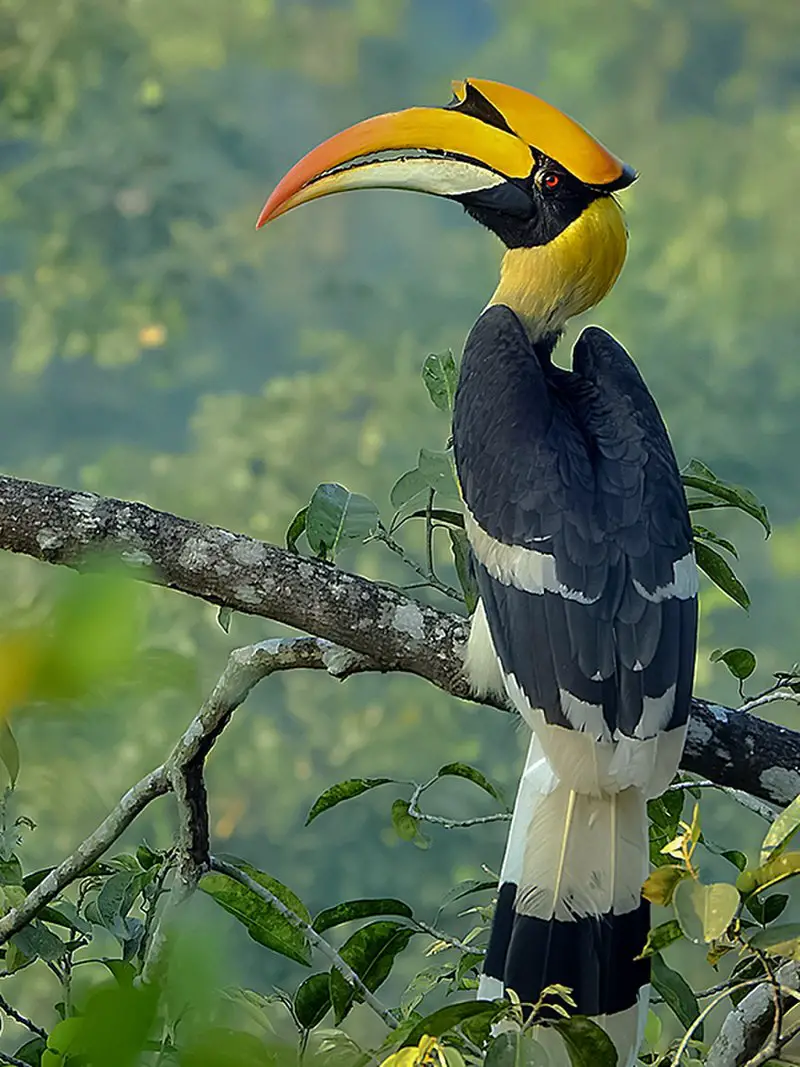
The Great hornbill is an impressive bird, belonging to the family of Hornbills. It can be found in India and Southeast Asia, mainly eating fruits but also preying on small mammals, reptiles and birds.
Its striking looks include a concave casque which sits atop its head as well as vibrant yellow-orange feathers covering much of its body.
Unfortunately it’s listed by IUCN Red List since 2018 due to habitat loss resulting from deforestation for agriculture and timber logging activities taking place across the world today.
Despite this sad news there are still conservation measures being taken such as education programs focusing on sustainable farming practices that will help protect this amazing species’ future.Scientific classification:
| Kingdom | Animalia |
| Phylum | Chordata |
| Class | Aves |
| Order | Bucerotiformes |
| Family | Bucerotidae |
| Genus | Buceros |
| Species | B. bicornis |
Also Featured In: Birds That Live in the Jungle, Common Tropical Rainforest Birds
2. Burmese Shrike
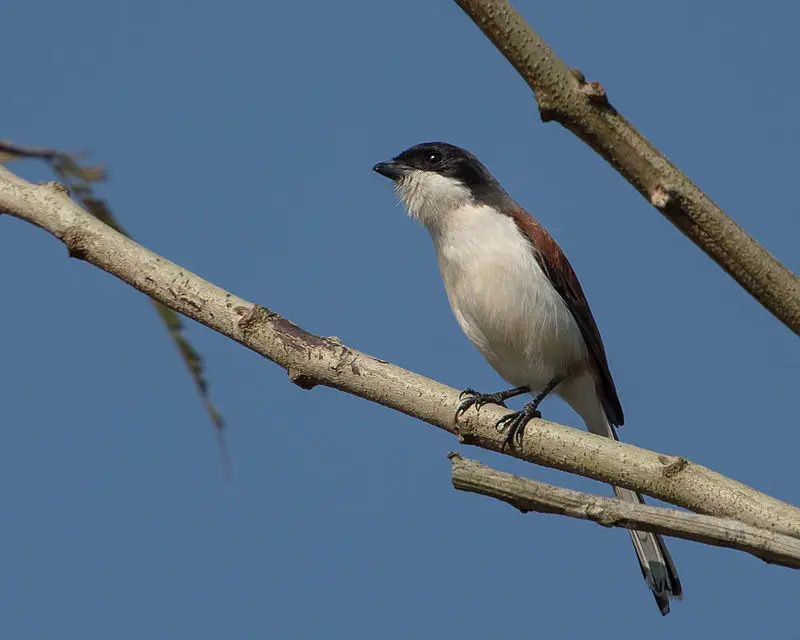
The Burmese shrike is a species of bird belonging to the family Laniidae. It lives in several countries across southern Asia, including Bangladesh, Cambodia, China, India, Laos Myanmar Thailand and Vietnam.
Its natural habitats are subtropical or tropical moist lowland forests as well as montane forests. The bird has an overall greyish-brown coloration with lighter areas on its belly and wing coverts; it also sports black streaks along its back while some individuals may have reddish tinges around their heads.
Their diet consists of insects such as beetles and caterpillars that they catch by swooping down from branches onto them before returning to the same spot again afterwards.
They are known to be quite shy birds but can sometimes be spotted perched atop trees where they stay alert for potential prey items flying below themScientific classification:
| Kingdom | Animalia |
| Phylum | Chordata |
| Class | Aves |
| Order | Passeriformes |
| Family | Laniidae |
| Genus | Lanius |
| Species | L. collurioides |
3. Black-Headed Ibis
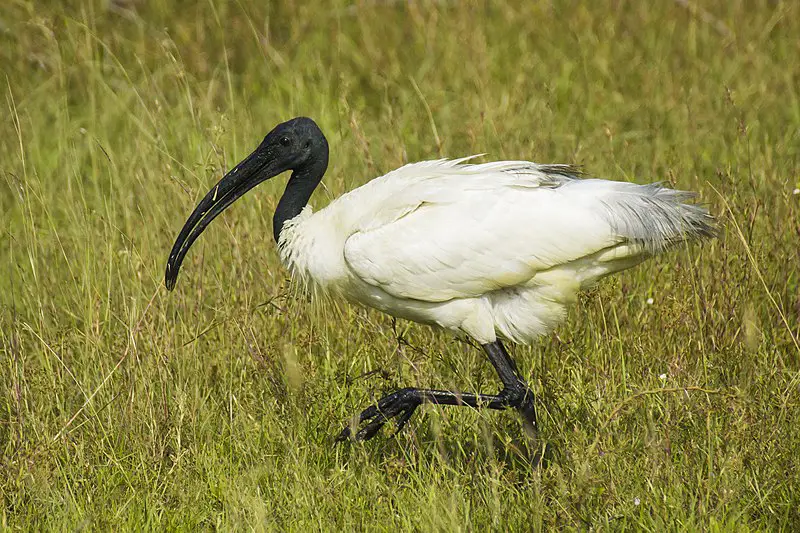
The Black-headed ibis is a majestic wading bird that can be found in areas of South and Southeast Asia, stretching from India to Japan.
It has an overall white plumage, with the most striking feature being its distinctive black neck.
These birds feed mainly on aquatic insects, small fish and frogs which they catch while walking slowly along shallow waters or sweeping their bill through them. They also eat worms, lizards and snails as well as some vegetation such fruits, grains etc..
Despite their wide range across different regions within South/Southeast Asia due to human activities like urbanisation and agricultural expansion.
This species’ population is decreasing at alarming rates making it critically endangered in certain parts of its natural habitat.Scientific classification:
| Kingdom | Animalia |
| Phylum | Chordata |
| Class | Aves |
| Order | Pelecaniformes |
| Family | Threskiornithidae |
| Genus | Threskiornis |
| Species | T. melanocephalus |
Also Featured In: Black And White Birds You Don’t Know About, Birds of Goa
4. Hooded Treepie
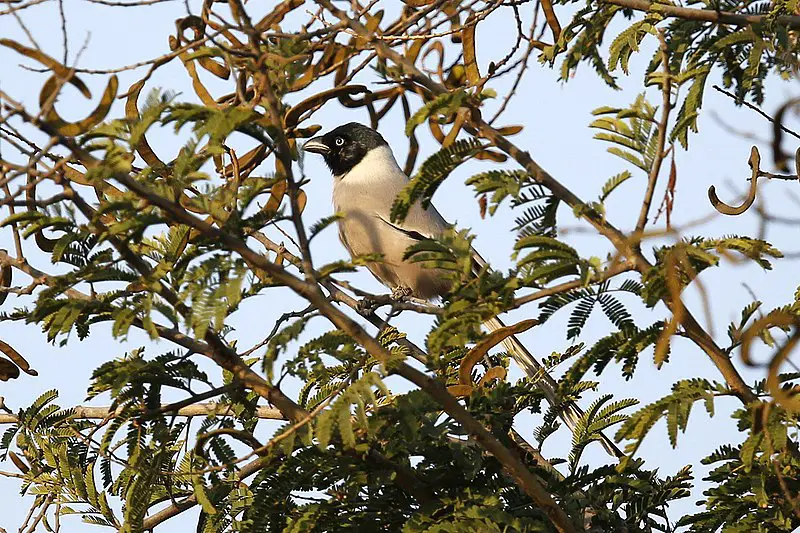
The Hooded Treepie is a species of bird belonging to the Corvidae family, which can only be found in Myanmar. It has an unmistakable grey plumage with black head, tail and flight feathers giving it a unique appearance.
Sadly, this small bird is threatened due to habitat loss as its natural habitats consist of subtropical or tropical moist lowland forest and subtropical or tropical dry shrubland.
Conservation efforts are needed for these birds if they are going to survive in their native land of Myanmar.
With proper protection from human activities such as deforestation and urbanization, hopefully we will see more Hooded Treepies around our world.Scientific classification:
| Kingdom | Animalia |
| Phylum | Chordata |
| Class | Aves |
| Order | Passeriformes |
| Family | Corvidae |
| Genus | Crypsirina |
| Species | C. cucullata |
5. Ayeyarwady Bulbul
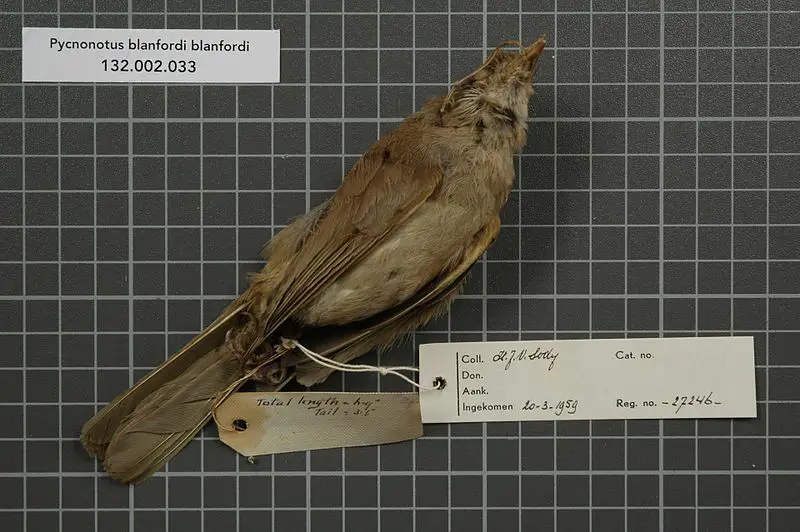
The Ayeyarwady bulbul is a species of passerine bird that belongs to the family of bulbuls. It is endemic to Myanmar and inhabits subtropical or tropical moist lowland forests.
This colorful bird has white, yellowish-white and black plumage on its body with an orange bill and two distinctive white stripes behind each eye.
Until 2016, it was believed to be conspecific with another type called the streak-eared bulbul which is now considered as a separate species known as Pycnonotus conradi.
Although relatively unknown beyond its native range, this beautiful bird can make an excellent pet due to its friendly demeanor towards humans when tamed properly over timeScientific classification:
| Kingdom | Animalia |
| Phylum | Chordata |
| Class | Aves |
| Order | Passeriformes |
| Family | Pycnonotidae |
| Genus | Pycnonotus |
| Species | P. blanfordi |
Also Featured In: Ko Samet Birds You Need To Know,
6. Masked Finfoot
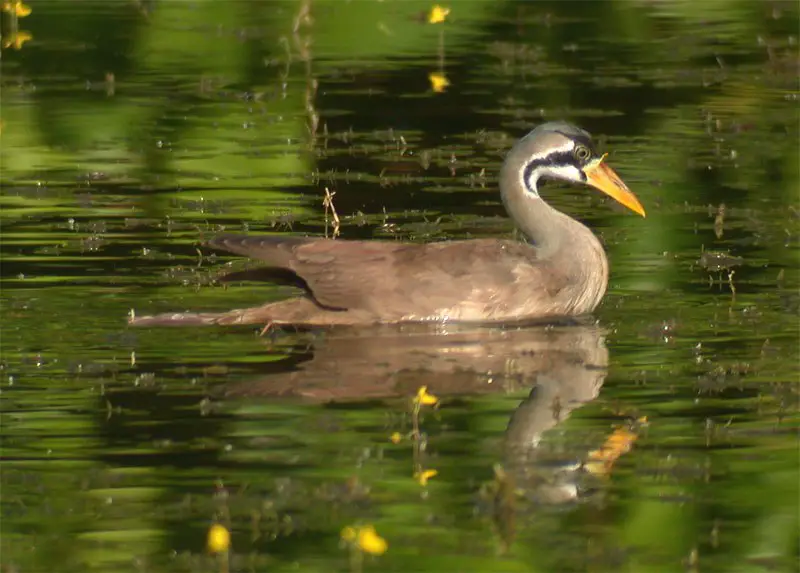
The Masked Finfoot is an endangered bird native to the fresh and brackish wetlands of Eastern India, Indochina, Malaysia and Indonesia.
It belongs to a family whose relationship with other birds remains largely unknown.
This aquatic species has distinct black-and-white plumage that covers its head like a mask while its back and wings are dark green in color.
Its striking red eyes stand out against this otherwise monotone appearance.
The masked finfoot can stay underwater for long periods due to their laterally compressed bodies which help them maneuver through water quickly and efficiently.
They feed mainly on fish but also consume frogs, crustaceans, mollusks, insects and even some plant material from time to time providing valuable ecosystem services such as controlling insect populations near riverside habitatsScientific classification:
| Kingdom | Animalia |
| Phylum | Chordata |
| Class | Aves |
| Order | Gruiformes |
| Family | Heliornithidae |
| Genus | Heliopais Sharpe, 1893 |
| Species | H. personatus |
7. Gurney’s Pitta
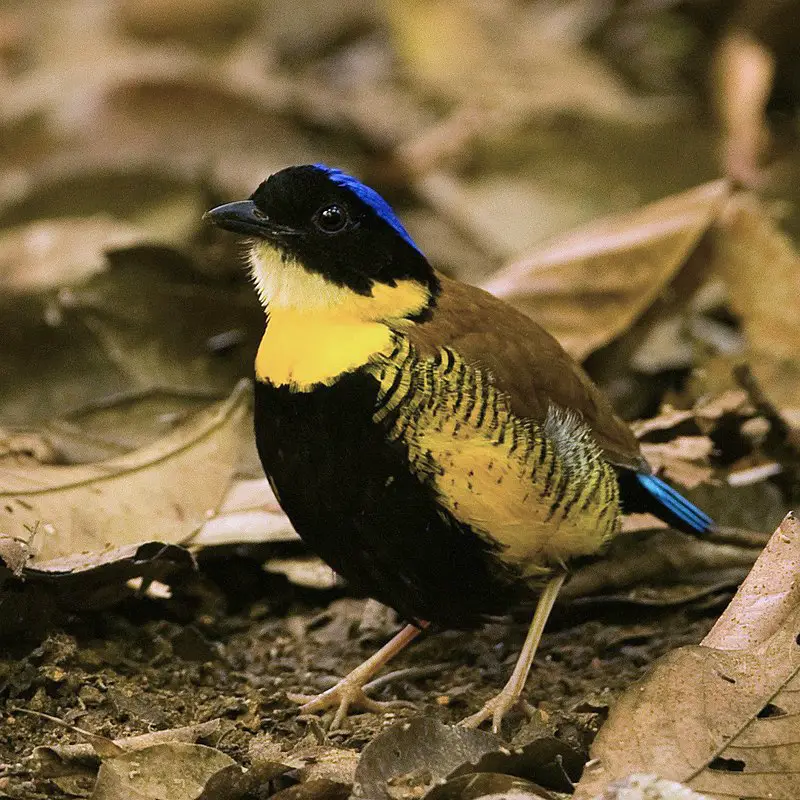
Gurney’s pitta is a medium-sized passerine bird, named after the British banker and amateur ornithologist John Henry Gurney. They can be found in the Malay Peninsula, mainly in Myanmar.
The diet of these birds consists mostly of slugs, insects and earthworms. These beautiful creatures have black bellies with white feathers on their back along with chestnut brown wings and tail feathers that create a unique contrast against its surroundings.
Their bright yellow crowns make them stand out even more. It has been suggested that logging activities are one of the main threats to this species as it destroys much needed habitat for food sources such as worms or snails during breeding season.
Conservation efforts must continue if we want to ensure these stunning birds remain part of our environment for years to come.Scientific classification:
| Kingdom | Animalia |
| Phylum | Chordata |
| Class | Aves |
| Order | Passeriformes |
| Family | Pittidae |
| Genus | Hydrornis |
| Species | H. gurneyi |
8. White-Bellied Heron
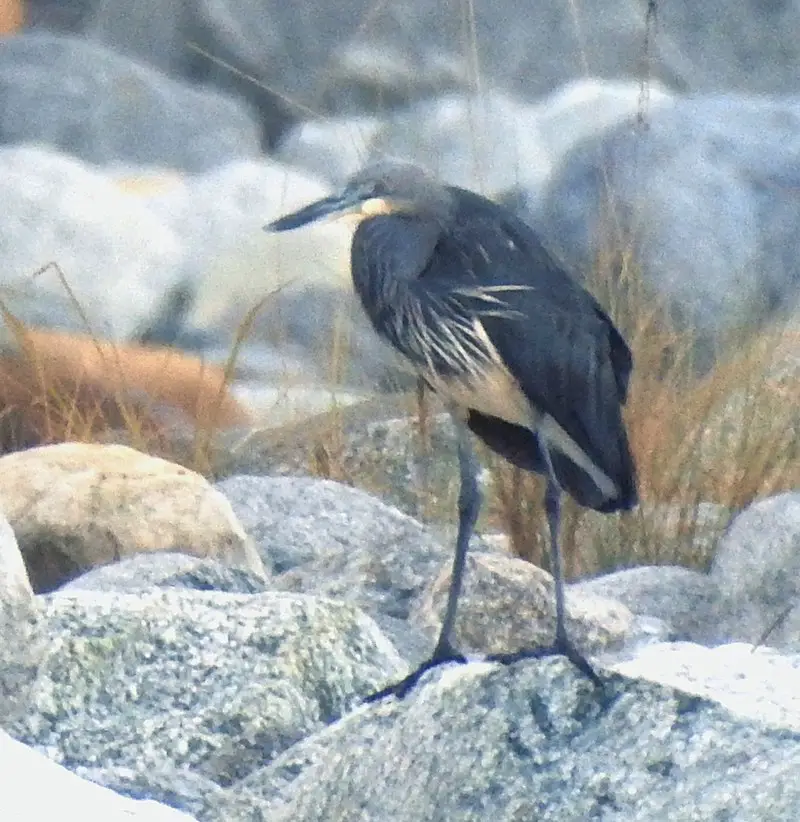
The white-bellied heron, also known as the imperial or great white-bellied heron, is a large species of bird native to eastern Himalayas and parts of northeast India.
It inhabits undisturbed rivers and wetlands in these areas and has long been an important part of the local ecosystem.
Unfortunately their numbers have dwindled over time due to human activities such as deforestation leading them being listed as critically endangered by IUCN Red List since 2007.
This majestic bird stands about up 1m tall with its body mainly covered in grey feathers while its head is topped off with a beautiful crown of black feathers that contrast against it’s white chest plumage – making it quite impressive sight when seen close up.
As they are so rare now, conservation efforts are essential if we want to protect this vibrant species from extinction for generations come.Scientific classification:
| Kingdom | Animalia |
| Phylum | Chordata |
| Class | Aves |
| Order | Pelecaniformes |
| Family | Ardeidae |
| Genus | Ardea |
| Species | A. insignis |
9. Plain-Pouched Hornbill
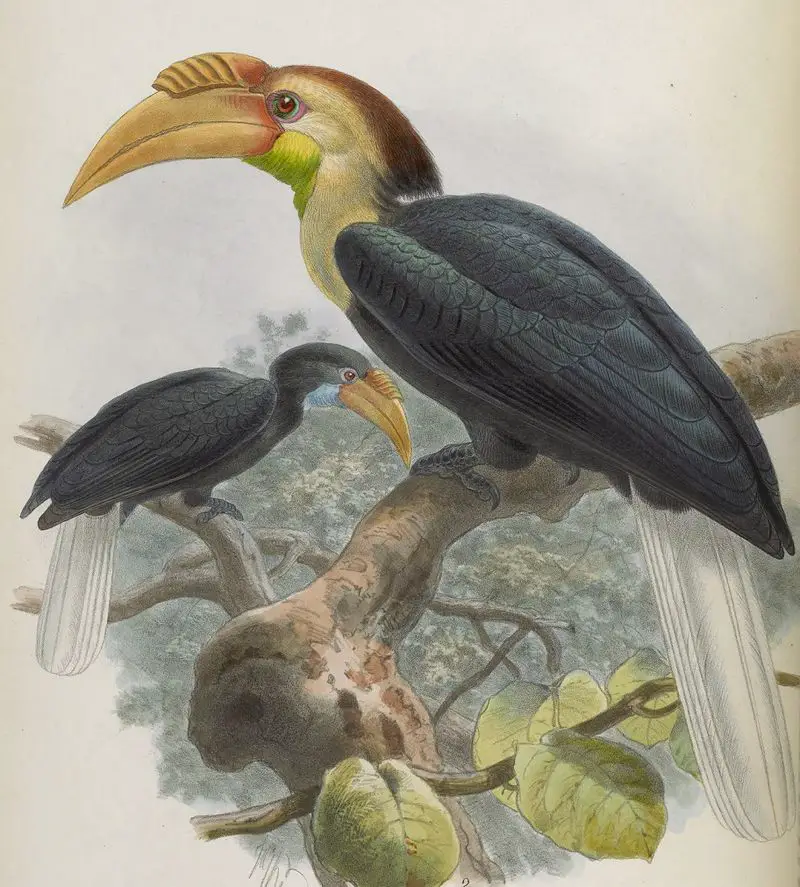
The Plain-pouched Hornbill is a species of bird found in forests located in Southern Myanmar, Western Thailand and Northern Peninsular Malaysia. It has unique features like its plain-colored pouch below the beak which distinguishes it from other hornbills.
This beautiful bird is facing threats due to habitat loss caused by human activities such as deforestation and hunting for food or decoration purposes. Conservation efforts should be taken up to protect this endangered species before they become extinct forever.Scientific classification:
| Kingdom | Animalia |
| Phylum | Chordata |
| Class | Aves |
| Order | Bucerotiformes |
| Family | Bucerotidae |
| Genus | Rhyticeros |
| Species | R. subruficollis |
10. Oriental Pied Hornbill
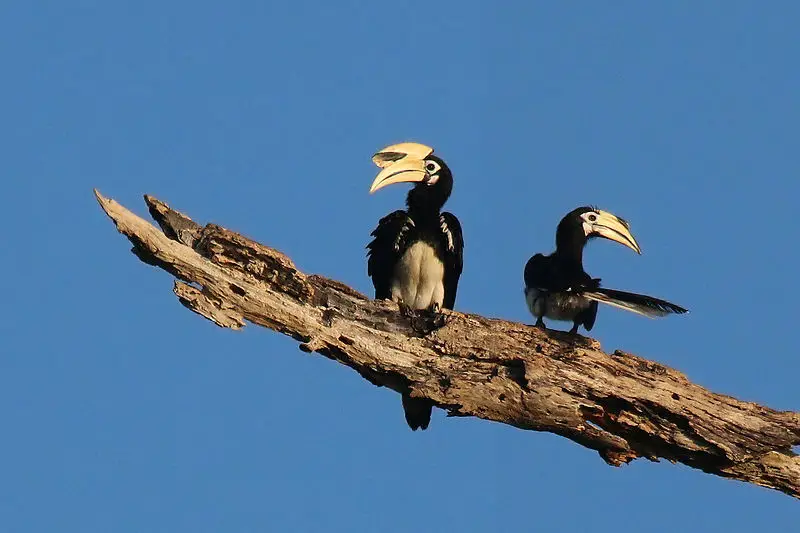
The Oriental Pied Hornbill is a species of Indo-Malayan bird belonging to the Bucerotidae family.
It’s one of the smallest and most common Asian hornbills, with its largest distribution found in the genus Anthracoceros.
This medium sized bird has black feathers all over its body, except for white wings and a white tail that make it stand out from other birds.
Its bill is yellow on top and red underneath, while their feet are greyish black.
These colorful characteristics help them blend into various habitats such as tropical forests or woodlands.
The diet consists mainly of fruits but they also feed on insects and small vertebrates like lizards or nesting birds’ eggs when available during certain seasons throughout their range habitat areas.
Monogamous pairs of birds construct their nests together using dead branches to create a secure chamber where the female can lay her eggs.
They carefully tend to the eggs until they hatch, and then rejoin their partner at nightfall.
These nests are often located near sources of food, in the beautiful and picturesque surroundings of trees and landscapes. These locations provide stunning views and make for attractive tourist destinations.
The scenery is breathtakingly beautiful, with spectacular vistas and awe-inspiring panoramas that are sure to captivate and charm visitors.
The overall atmosphere of these locations is heavenly and paradisiacal, making them a delight to behold.
The incredible beauty and grace of these places are simply remarkable, and visitors are sure to be impressed by their elegance and distinguished grandeur.
It is an experience that is sure to leave a lasting impression on anyone who is lucky enough to visit.Scientific classification:
| Kingdom | Animalia |
| Phylum | Chordata |
| Class | Aves |
| Order | Bucerotiformes |
| Family | Bucerotidae |
| Genus | Anthracoceros |
| Species | A. albirostris |
Also Featured In: Birds that Live in Borneo Island, Birds That You’ll See in Kaziranga National Park
11. Maroon Oriole
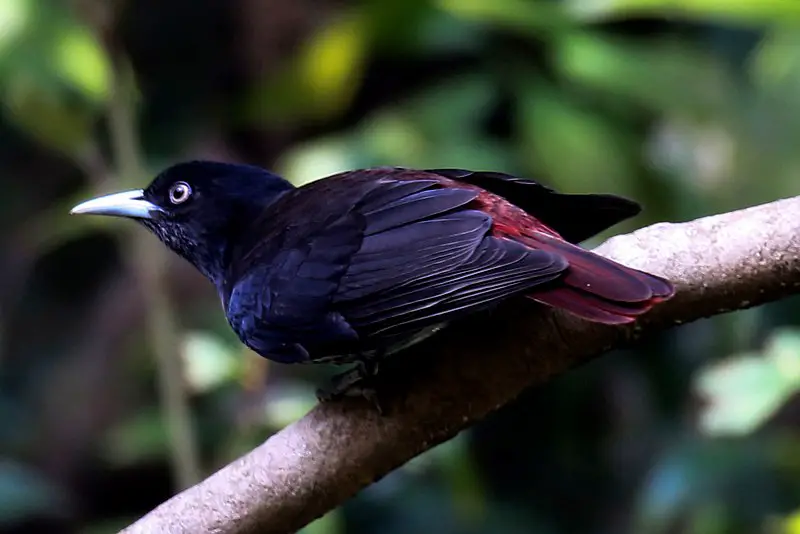
The Maroon Oriole is a species of bird belonging to the family Oriolidae, found in Southeast Asia. Its plumage consists of maroon and black colors along with a black head, neck, breast and wings.
It belongs to a clade that includes four other orioles such as the Black-and-Crimson Orioles and Silver Orioles.
In addition it was originally described under the genus Pastor when first discovered by scientists during its classification process.
The Maroon Oriole lives mainly on fruits but will also eat insects or small lizards if available for food sources; this makes them omnivorous creatures which can adapt to different situations according to their environment’s needs.
Their diet has made them quite popular among both local people living nearby as well as tourists who are looking for an interesting sighting while visiting these regions.Scientific classification:
| Kingdom | Animalia |
| Phylum | Chordata |
| Class | Aves |
| Order | Passeriformes |
| Family | Oriolidae |
| Genus | Oriolus |
| Species | O. traillii |
Also Featured In: Birds that Commonly Found in Andhra Pradesh,
12. Wreathed Hornbill
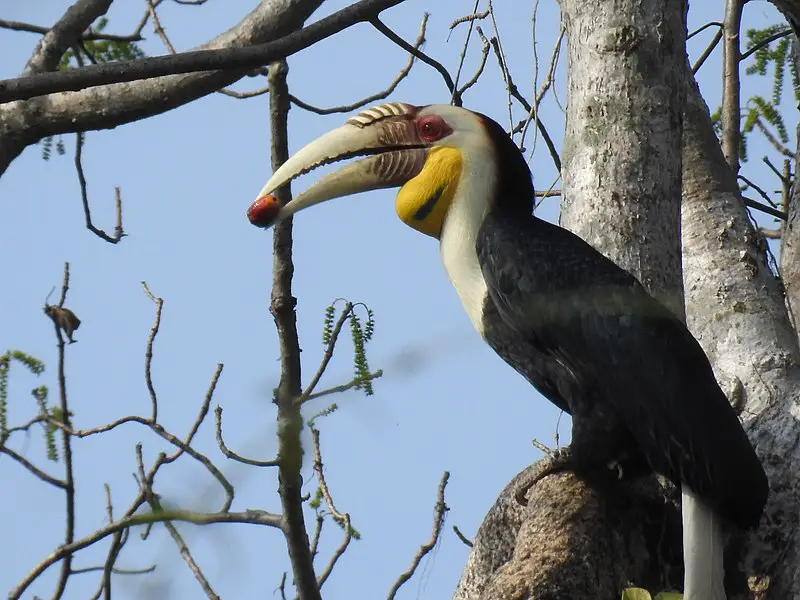
The Wreathed Hornbill is a magnificent bird found in the Old World tropics. It has an unmistakable curved bill that develops ridges, or wreaths, on its upper mandible as it matures.
The male of this species is black with a rufous crown and white underparts while females are mostly brownish-black all over.
On their lower throat sacs they have an eye-catching blue-black band which gives them their other name – Bar-pouched Wreathed Hornbills.
These birds mainly feed on fruits but also enjoy insects sometimes too. They nest inside tree hollows lined with mud and feathers to keep the eggs safe from predators and weather elements alike.
Though threatened by habitat loss due to deforestation, these beautiful creatures can still be seen flying around forests across Southeast Asia today.Scientific classification:
| Kingdom | Animalia |
| Phylum | Chordata |
| Class | Aves |
| Order | Bucerotiformes |
| Family | Bucerotidae |
| Genus | Rhyticeros |
| Species | R. undulatus |
13. Green-Backed Tit
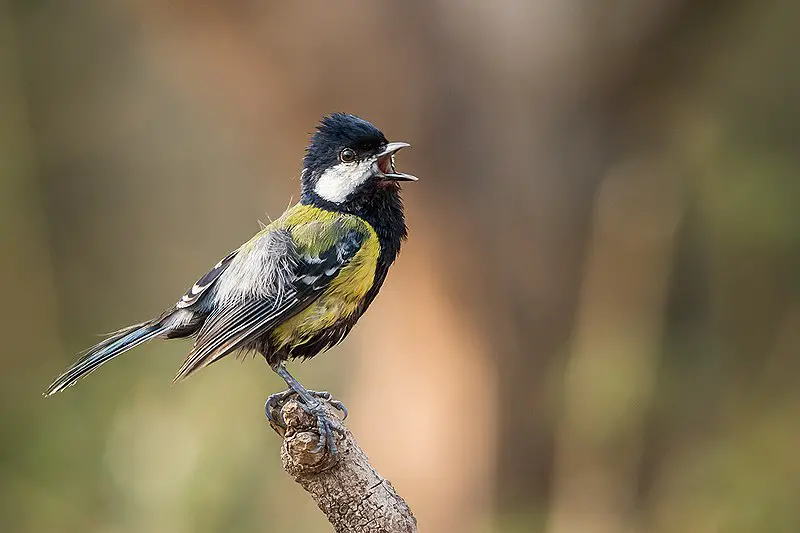
The Green-backed tit is an adorable species of bird in the family Paridae and can be found across many countries, including Bangladesh, Bhutan, China, India, Laos Myanmar Nepal and Pakistan.
They inhabit boreal forests along with temperate and subtropical moist lowland forests where they are often seen searching for food on tree branches or flying between trees.
These birds have a distinctive green back which makes them easily recognizable when spotted in their natural habitats.
The Green-backed tit has adapted well to life amongst humans too as it has been observed visiting gardens located close by woodlands looking for food scraps left behind by humans.
This remarkable little bird may not be one of the most recognized species but its presence should certainly never go unnoticed.Scientific classification:
| Kingdom | Animalia |
| Phylum | Chordata |
| Class | Aves |
| Order | Passeriformes |
| Family | Paridae |
| Genus | Parus |
| Species | P. monticolus |
14. River Lapwing
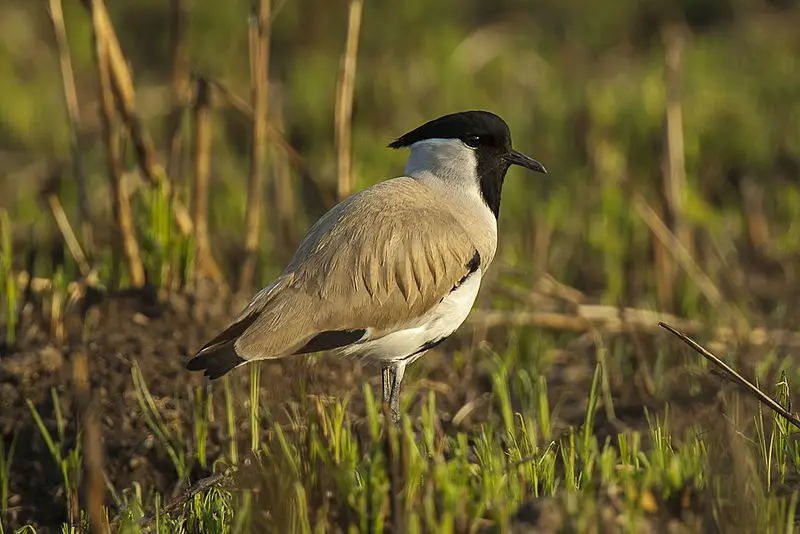
The River Lapwing is a striking black and white bird with long legs and an orange crest upon its head. It can be found throughout much of northern India as well as parts of Southeast Asia, including Vietnam.
This species rarely migrates and tends to stay in the same general area year-round.
The river lapwing has unique features that make it stand out from other birds, such as its bright yellow eyes, short bill, large wingspan for better flight stability, spur-like feathers on its inner wing joints which are used for protection against predators or rivals during mating season.
Despite being quite beautiful when seen up close, this species often goes unnoticed due to their small size; they typically measure between 25 – 28 cm long.Scientific classification:
| Kingdom | Animalia |
| Phylum | Chordata |
| Class | Aves |
| Order | Charadriiformes |
| Family | Charadriidae |
| Genus | Vanellus |
| Species | V. duvaucelii |
Also Featured In: Common Birds that Live in Odisha, Birds that Live in Rajasthan
15. Slender-Billed Oriole
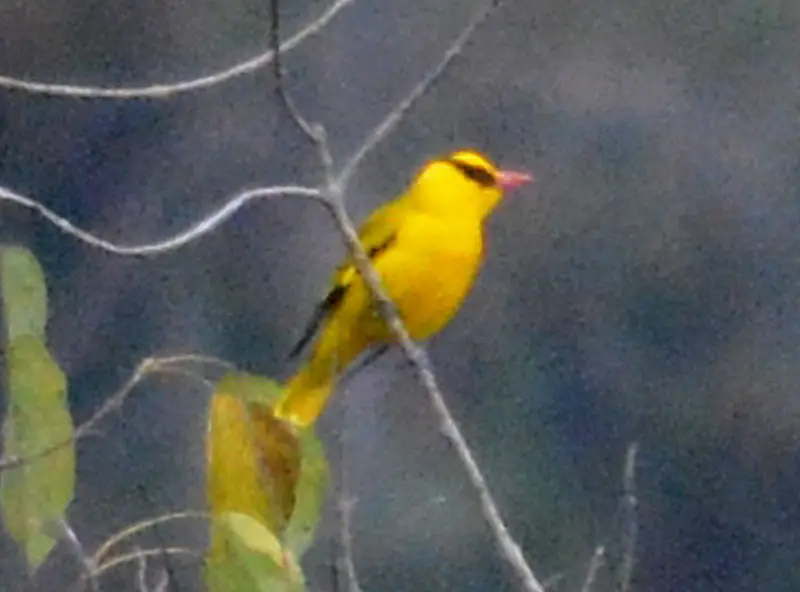
The Slender-billed Oriole is a species of bird found in the eastern Himalayas and Southeast Asia. It inhabits subtropical or tropical moist forests, both lowland and montane.
This beautiful bird has two recognised subspecies: O. tenuirostris tenuirostris and O. tesnuirostris albigularis . The former lives in India while the latter can be seen from Assam to Northern Vietnam.
It feeds on insects, small fruits, berries as well as grains it finds at ground level or up to 10 m high in trees foraging for food especially during the breeding season when its diet changes considerably due to increased need for energy by young birds being fed mainly insects such as grasshoppers and beetles among others..
Its coloration contains tones of yellow with black wings tips which give them an amazing elegant look that makes this species very appealing even without hearing their sweet melodious chirping.Scientific classification:
| Kingdom | Animalia |
| Phylum | Chordata |
| Class | Aves |
| Order | Passeriformes |
| Family | Oriolidae |
| Genus | Oriolus |
| Species | O. tenuirostris |
16. Yellow-Cheeked Tit
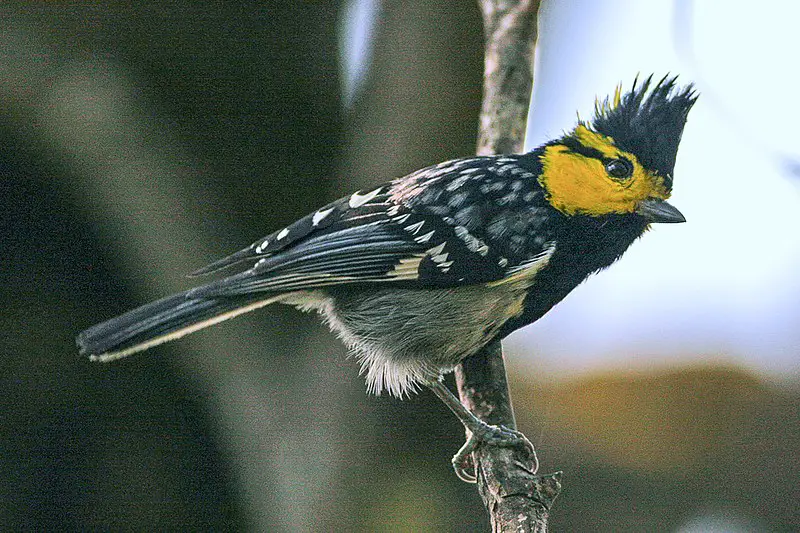
The yellow-cheeked tit is a species of bird found in Bangladesh, Bhutan, China and other parts of Asia. It inhabits subtropical or tropical lowland forests and montane forests.
The male has distinctive bright yellow cheeks that contrast sharply with the black crown on its head but the female’s plumage is generally drabber than the males’.
They are very active birds, often flitting about from tree to tree searching for insects, seeds and berries which make up their diet.
Their nests consist of small cups made out of grasses built high in trees near water sources such as streams or rivers.
These colourful little birds may be seen alone or in small groups throughout much of Southeast Asia where they are not considered threatened due to their wide range and large population numbers.Scientific classification:
| Kingdom | Animalia |
| Phylum | Chordata |
| Class | Aves |
| Order | Passeriformes |
| Family | Paridae |
| Genus | Machlolophus |
| Species | M. spilonotus |
17. Mangrove Pitta
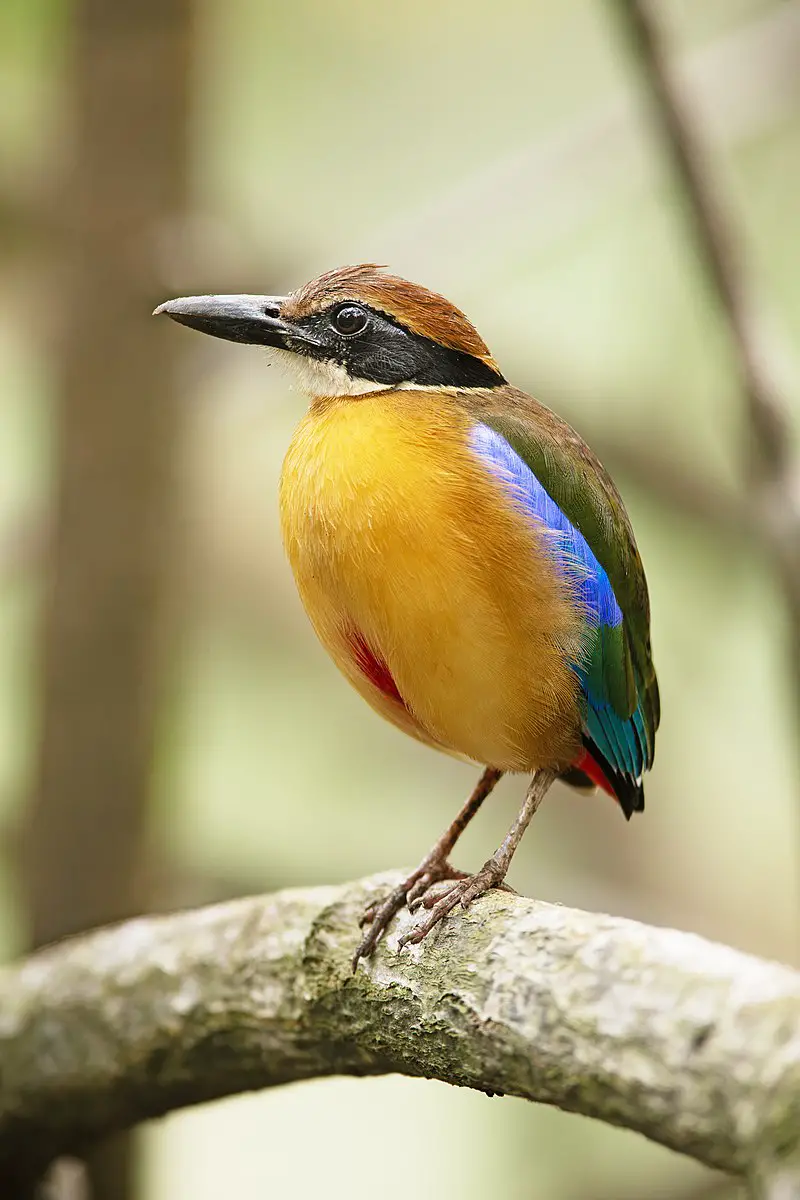
The Mangrove pitta is an exquisite passerine bird with a striking black head and brown crown. There throat is white, while their upper part has a vibrant greenish hue that makes them stand out in the crowd.
This species belongs to the Pittidae family, which includes Indian pittas, fairy pittas and blue-winged ones – however it does not have any subspecies of its own.
Endemic to eastern India and western Southeast Asia, this chirpy little creature loves spending time near mangroves where they can easily find food from their favourite diet consisting mostly of insects.
Their beautiful feathers make them quite attractive to potential predators as well so they must be on high alert whenever they venture outside.Scientific classification:
| Kingdom | Animalia |
| Phylum | Chordata |
| Class | Aves |
| Order | Passeriformes |
| Family | Pittidae |
| Genus | Pitta |
| Species | P. megarhyncha |
18. Great Stone-Curlew
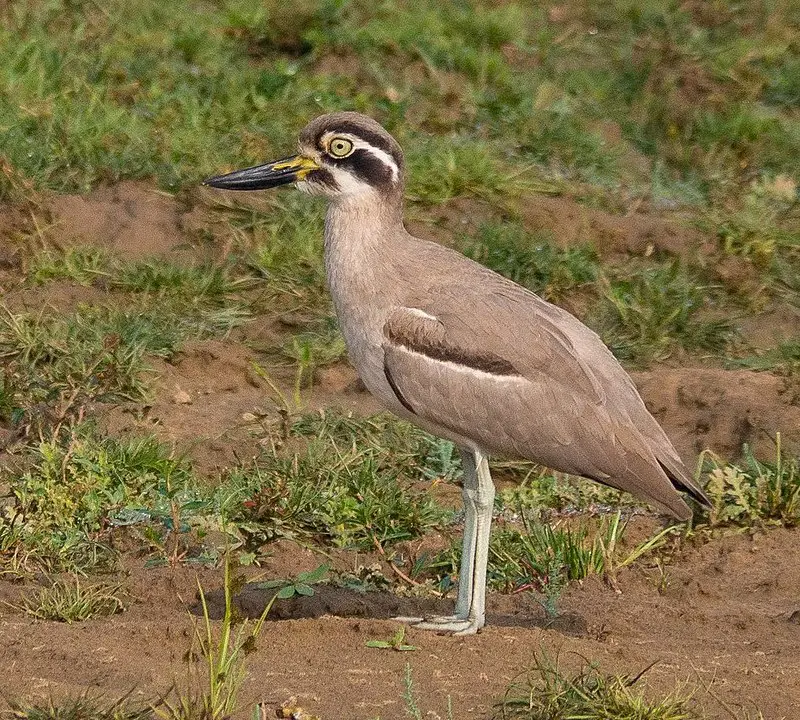
The Great Stone-Curlew, also known as the great thick-knee, is a large wader found in tropical southern Asia. It stands out with its long yellow legs and brownish plumage.
This bird was first described by French naturalist Georges Cuvier in 1829 who gave it the scientific name Oedicnemus recurvirostris, with Nepal being its type locality.
The species prefers to inhabit open country like steppes or grasslands where they hunt for prey on foot during night time while keeping watch from high perches during daybreak.
They are monogamous birds that breed between April – June and form strong pair bonds throughout their lifetime.Scientific classification:
| Kingdom | Animalia |
| Phylum | Chordata |
| Class | Aves |
| Order | Charadriiformes |
| Family | Burhinidae |
| Genus | Esacus |
| Species | E. recurvirostris |
Also Featured In: Common Birds of Maharashtra, Urban Birds of Hong Kong
19. Orange-Bellied Leafbird
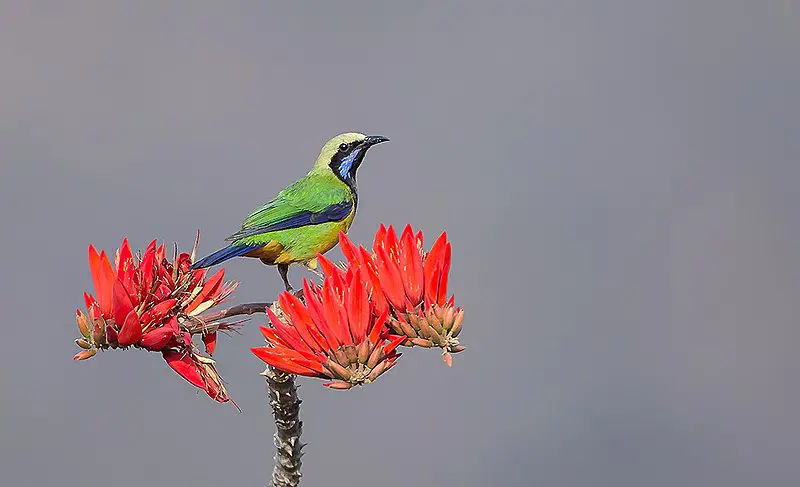
The Orange-bellied Leafbird is a beautiful bird native to central and eastern Himalayas, Yunnan and northern parts of Southeast Asia. It has an orange belly with green back, blue tail and face as well as red wings with black streaks on them.
Its scientific name commemorates the English naturalist Thomas Hardwicke. The Greyish-crowned Leafbird was formerly considered its conspecific but now it’s found in Hainan only.
This species feeds mainly on fruits, nectar from flowers or insects when available like other leafbirds do too.
Its call consists of two notes that are repeated at regular intervals making it easily recognizable amongst birds in this region .
Overall these colourful little birds bring life into their habitats by adding vibrancy to the environment they inhabit.Scientific classification:
| Kingdom | Animalia |
| Phylum | Chordata |
| Class | Aves |
| Order | Passeriformes |
| Family | Chloropseidae |
| Genus | Chloropsis |
| Species | C. hardwickii |
Also Featured In: Common Birds of Hainan,
20. Blue-Throated Barbet
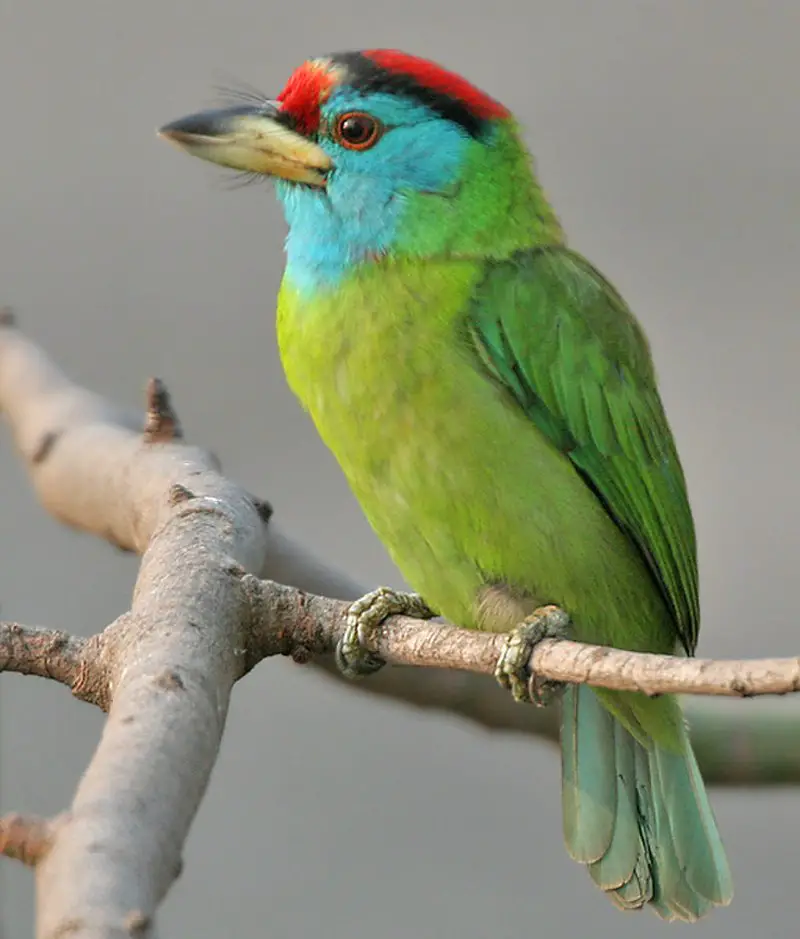
The Blue-throated barbet is a beautiful bird, native to the foothills of the Himalayas and Southeast Asia. It lives in lowland and montane forests from 200m up to 2,000m above sea level.
Its vibrant plumage consists of bright green, blue and red feathers. The species gets its name from the bristles which fringe their heavy bills; they feed on fruits as well as insects for sustenance.
These birds are quite small but have strong voices that can be heard echoing through their habitats day or night.
They’re often seen alone or with other members of their group in trees looking out for food or simply enjoying each others company.
All in all these amazing creatures make an excellent addition to our natural world.Scientific classification:
| Kingdom | Animalia |
| Phylum | Chordata |
| Class | Aves |
| Order | Piciformes |
| Family | Megalaimidae |
| Genus | Psilopogon |
| Species | P. asiaticus |
21. Brown Bush Warbler
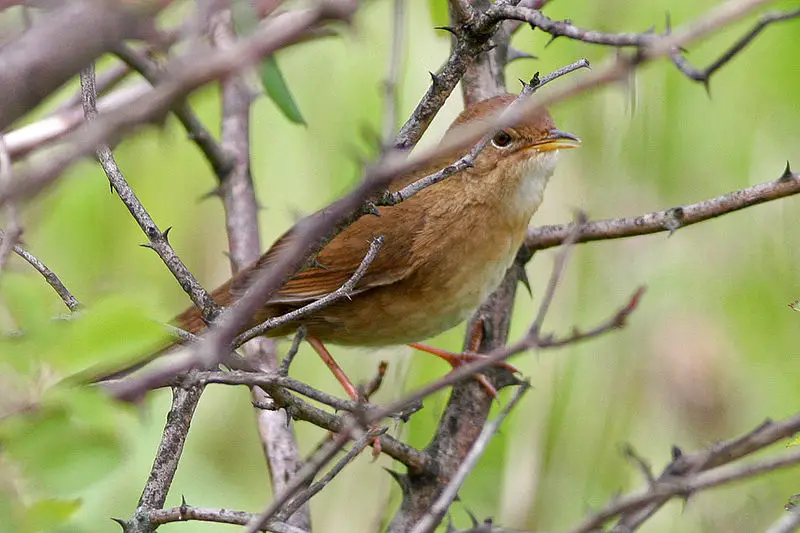
The Brown Bush Warbler is a songbird species that belongs to the newly recognized family Locustellidae. It can be found in parts of Bangladesh, Bhutan, China, Hong Kong, India, Myanmar, Nepal Thailand and Vietnam.
During breeding season it inhabits boreal forests while during other times of the year subtropical and tropical areas are preferred habitats.
This small bird has brownish upperparts with white underparts striped dark on sides as well as wings which are barred black-and-white above and plain grey below.
The bill is short but broad compared to other warblers making them easily recognizable among their peers.Scientific classification:
| Kingdom | Animalia |
| Phylum | Chordata |
| Class | Aves |
| Order | Passeriformes |
| Family | Locustellidae |
| Genus | Locustella |
| Species | L. luteoventris |
22. Brown-Breasted Bulbul
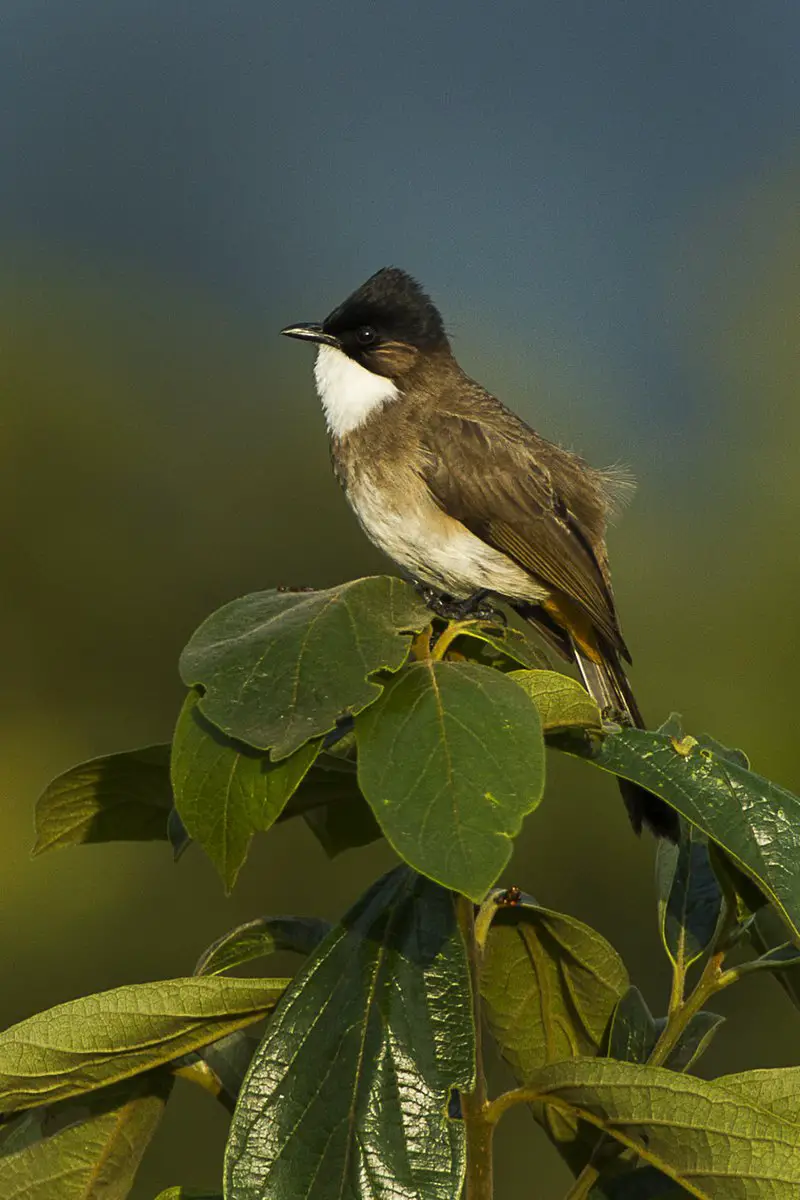
The Brown-breasted Bulbul is a songbird from the Pycnonotidae family, first described by John Anderson in 1869. It typically inhabits south-east Asia and can be found across central and southern China to Myanmar and northern Thailand.
This species of bird has several alternate names including Anderson’s bulbul or yellow-vented bulbul which should not be confused with the other species that share the same name.
The plumage of these birds usually consists of dark brown upperparts, white throat and underparts along with some yellow on its vent area adding more colour to their appearance.
They have short tails as well as pointed bills making them easily identifiable among other birds in this region. Brown-breasted bulbuls are known for producing various melodious sounds due to their vocal nature which makes them an interesting addition to any location they inhabit.Scientific classification:
| Kingdom | Animalia |
| Phylum | Chordata |
| Class | Aves |
| Order | Passeriformes |
| Family | Pycnonotidae |
| Genus | Pycnonotus |
| Species | P. xanthorrhous |
23. Black-Tailed Crake
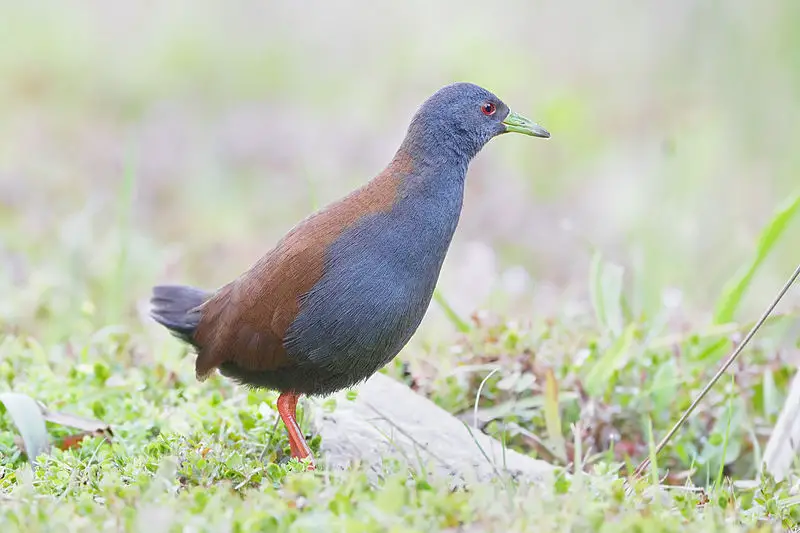
The Black-tailed Crake is an elegant bird found in many Asian countries such as Bangladesh, Bhutan, China, India and Myanmar. It has a distinctive slate gray colour with chestnut brown back feathers and red eyes that give it a striking appearance.
Its slender legs are coloured pinkish-red. The crake prefers to live in moist montane forests but can also be seen near ponds or rivers where there is plenty of vegetation for them to feed on.
They tend to stay close to the ground rather than fly high up into the trees like other species of birds do.
The black-tailed crake makes its home in subtropical or tropical areas which provide ideal conditions for these beautiful creatures.Scientific classification:
| Kingdom | Animalia |
| Phylum | Chordata |
| Class | Aves |
| Order | Gruiformes |
| Family | Rallidae |
| Genus | Zapornia |
| Species | Z. bicolor |
24. Blue Pitta
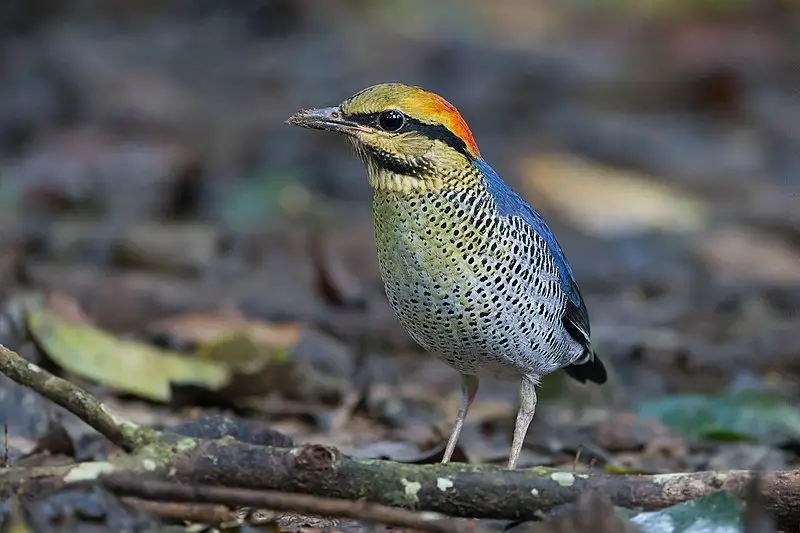
The Blue Pitta is a vibrant and beautiful bird that belongs to the family of Pittidae. It can be found in moist forests, dry forests, and across the northeastern Indian subcontinent, southern China, and Indochina.
They are generally solitary birds with stocky bodies characterized by their long tail feathers which contrast against their bright blue plumage.
The diet of these birds consists mainly of insects and other small invertebrates which they forage from the ground or low-lying trees.
Overall this species has adapted well to its environment though it remains relatively inconspicuous due to its shyness towards humansScientific classification:
| Kingdom | Animalia |
| Phylum | Chordata |
| Class | Aves |
| Order | Passeriformes |
| Family | Pittidae |
| Genus | Hydrornis |
| Species | H. cyaneus |
25. Bay Woodpecker
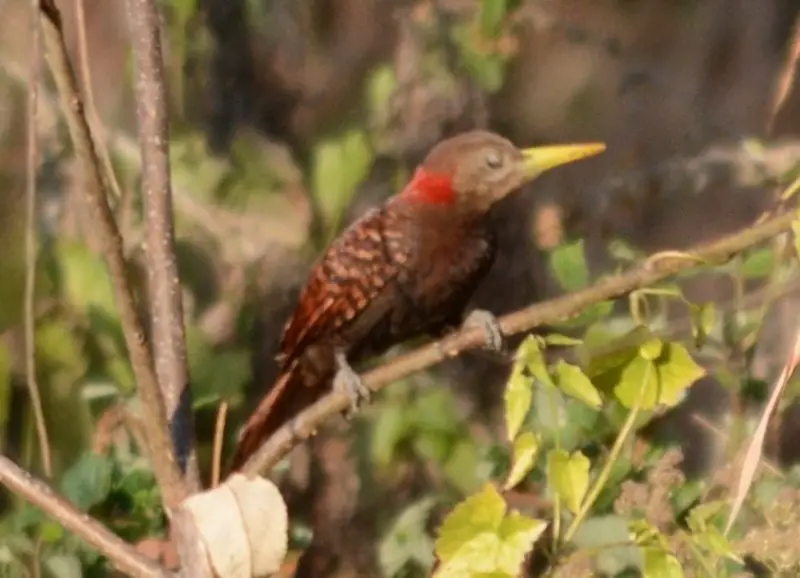
The Bay Woodpecker is a species of bird found in many parts of Asia, from Bangladesh to Vietnam. This small but colorful bird lives in subtropical or tropical moist lowland and montane forests.
It has an olive-brown back with white barring on the wings and tail feathers, while its belly is yellowish-white spotted with cinnamon brown. Its diet consists mainly of insects such as ants, beetles, termites and caterpillars.
The call of this woodpecker can be heard echoing through the trees – it’s a loud “krrr” noise.
As well as foraging for food alone or in pairs during the day time, they also use their long bills to excavate nest cavities high up into tree trunks where they lay eggs at night time.
These birds are important seed dispersers due to their constant movement between habitats which helps spread new varieties of plants throughout different areas – making them essential components within local ecosystems.Scientific classification:
| Kingdom | Animalia |
| Phylum | Chordata |
| Class | Aves |
| Order | Piciformes |
| Family | Picidae |
| Genus | Blythipicus |
| Species | B. pyrrhotis |
26. Bamboo Woodpecker
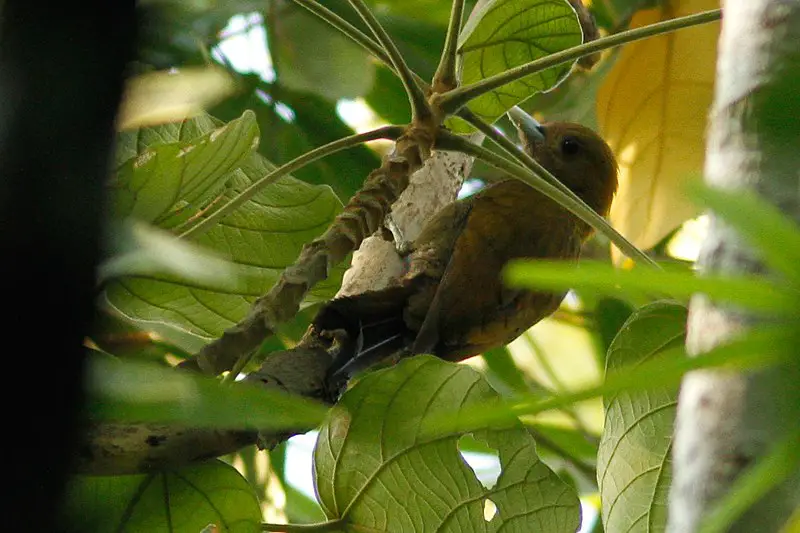
The Bamboo Woodpecker is a species of bird found in Myanmar, Laos, Thailand and Malaysia. It has distinctive green plumage with black markings on its wings and tail feathers.
Its bill is yellowish-orange at the base, becoming white towards the tip.
The woodpecker lives mainly in subtropical or tropical dry forests as well as moist lowland forests where it feeds mostly on insects hidden inside bamboo shoots or trees such as palm oil and rubber trees.
This species plays an important role in maintaining healthy forest ecosystems by helping to disperse seeds from various plant types while foraging for food among deadwood branches.
These birds are also known to drum loudly against tree trunks when communicating with other members of their flock which can be heard up to 1 km away.Scientific classification:
| Kingdom | Animalia |
| Phylum | Chordata |
| Class | Aves |
| Order | Piciformes |
| Family | Picidae |
| Genus | Gecinulus |
| Species | G. viridis |
27. Blyth’s Tragopan
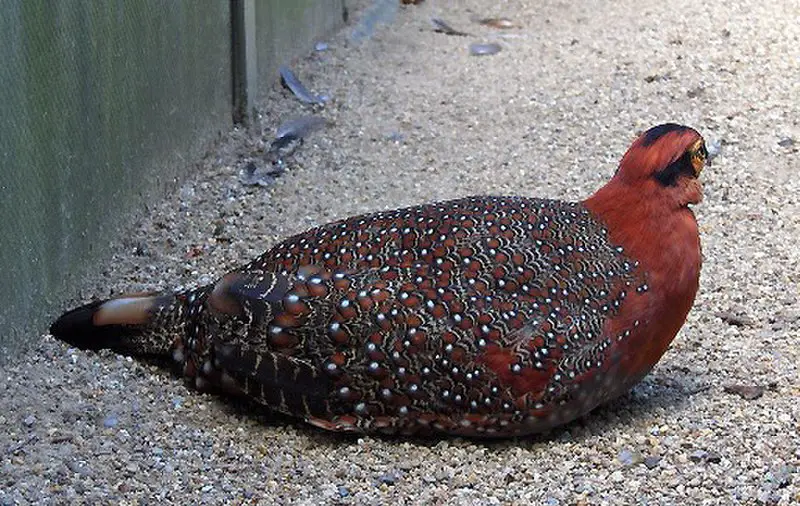
Blyth’s tragopan is a pheasant species that is currently classified as vulnerable. It was named after Edward Blyth, an English zoologist and Curator of the Museum of the Asiatic Society of Bengal in 1810–1873.
This colorful bird has black and white feathers on its wings with grey bellies. The population for this species is small and believed to be decreasing rapidly due to human activity such as habitat destruction and hunting for food or sport purposes.
They can be found in various areas including Bhutan through India up into China, across Southeast Asia towards Thailand, Vietnam and Cambodia.
To conserve these birds it’s essential we protect their habitats by limiting activities like logging which are destroying natural environments where they live while also increasing public awareness about them so people will take more action to help save them from extinction.Scientific classification:
| Kingdom | Animalia |
| Phylum | Chordata |
| Class | Aves |
| Order | Galliformes |
| Family | Phasianidae |
| Genus | Tragopan |
| Species | T. blythii |
28. White-Browed Nuthatch
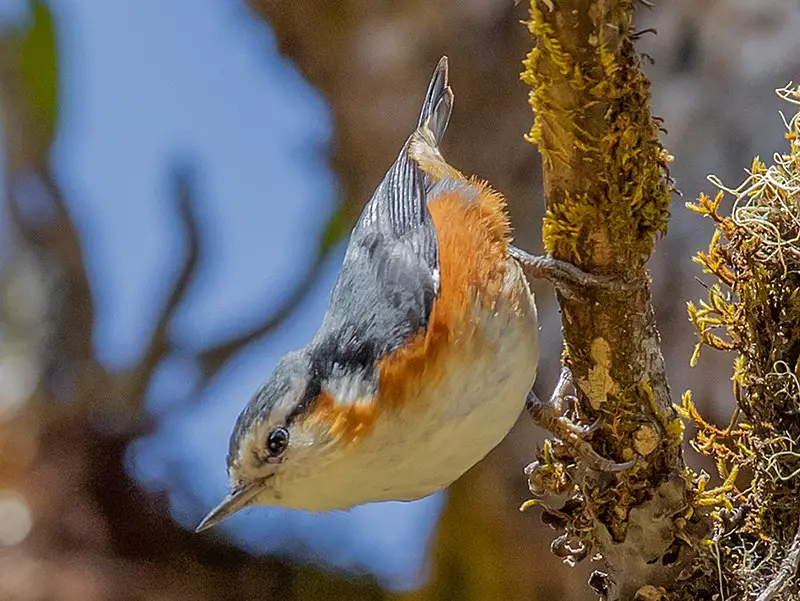
The White-browed Nuthatch is a species of bird in the Sittidae family. It has upperparts that are gray-blue and white underparts on its throat, cheeks, and breast as well as orange coloring on its flanks, belly and lower abdomen.
This small nuthatch measures 11.5 cm (4.5 inches) with no sexual dimorphism between sexes.
They can be found in Southeast Asia from India to China inhabiting deciduous forests at low elevations up to about 2000 meters above sea level foraging for food mainly insects by climbing tree trunks using their sharp claws.
These birds have an unmistakable call which sounds like “chik chiki” making them easy to spot if you keep your ears open while walking through their natural habitatScientific classification:
| Kingdom | Animalia |
| Phylum | Chordata |
| Class | Aves |
| Order | Passeriformes |
| Family | Sittidae |
| Genus | Sitta |
| Species | S. victoriae |
29. Nordmann’s Greenshank
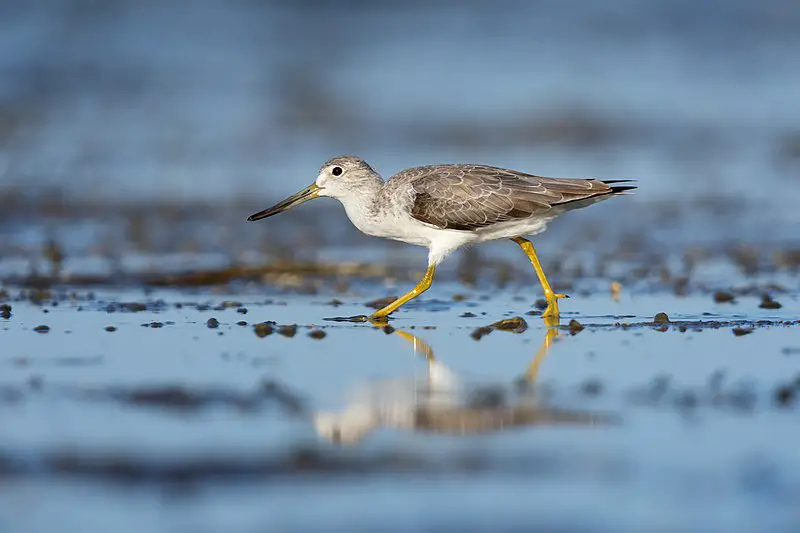
Nordmann’s greenshank is a species of wader belonging to the Scolopacidae family. It measures 29–32 cm (11-13 in) long and has an upturned bill that is bicolored; its legs are short, yellowish.
Breeding adults have white spots and streaks on their black upperside which make them easily distinguishable from other birds of similar sizes.
They inhabit coastal wetlands including estuaries, mudflats and shallow lagoons where they feed mainly on small invertebrates such as molluscs, crustaceans or aquatic insects by pecking at the surface water with their beaks.
Nordmann’s Greenshanks usually form monogamous pairs during breeding season but also large flocks outside breeding time when they migrate southwards towards tropical areas for wintering purposes.
These beautiful little creatures are considered Near threatened due to habitat destruction although some conservation actions have been taken in order to protect this species’ population levels worldwideScientific classification:
| Kingdom | Animalia |
| Phylum | Chordata |
| Class | Aves |
| Order | Charadriiformes |
| Family | Scolopacidae |
| Genus | Tringa |
| Species | T. guttifer |
30. Red-Vented Bulbul
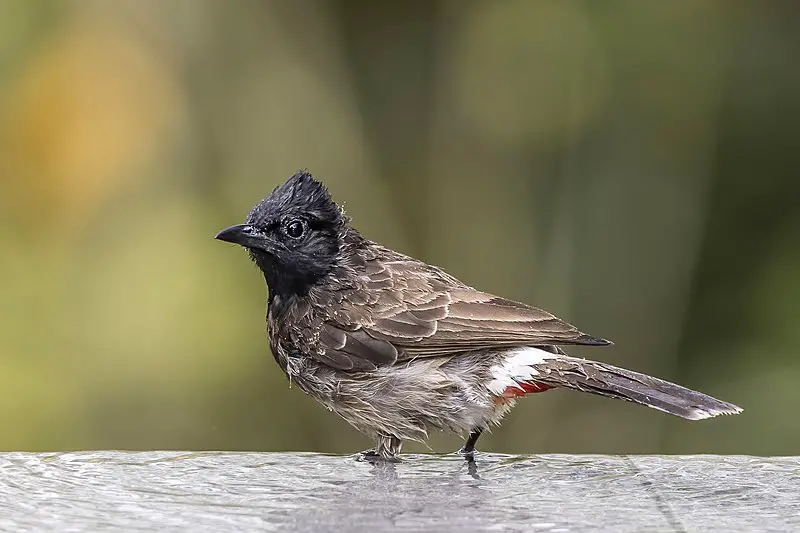
The Red-vented Bulbul is an impressive bird native to the Indian subcontinent, and has been introduced to regions around the world.
It belongs to the bulbul family of passerines and is a resident breeder in many countries including Sri Lanka, Burma, Bhutan and Nepal.
It also thrives in New Zealand, Argentina, Tonga and Fiji as well as parts of Samoa, Australia USA and Cook Islands.
This species has grey heads with white cheeks that contrast sharply against their black wings with bright red vent feathers which give them their name.
They typically live near woodland areas where they can forage for fruits or small insects on trees or bushes; this makes them useful birds for controlling insect populations naturally.
The male red-vented bulbuls are renowned songsters who sing out from treetops at dawn each day – adding some beautiful melodies to any garden.Scientific classification:
| Kingdom | Animalia |
| Phylum | Chordata |
| Class | Aves |
| Order | Passeriformes |
| Family | Pycnonotidae |
| Genus | Pycnonotus |
| Species | P. cafer |
Also Featured In: Common Birds in the Cities, Common Birds of Mumbai
31. Green Peafowl
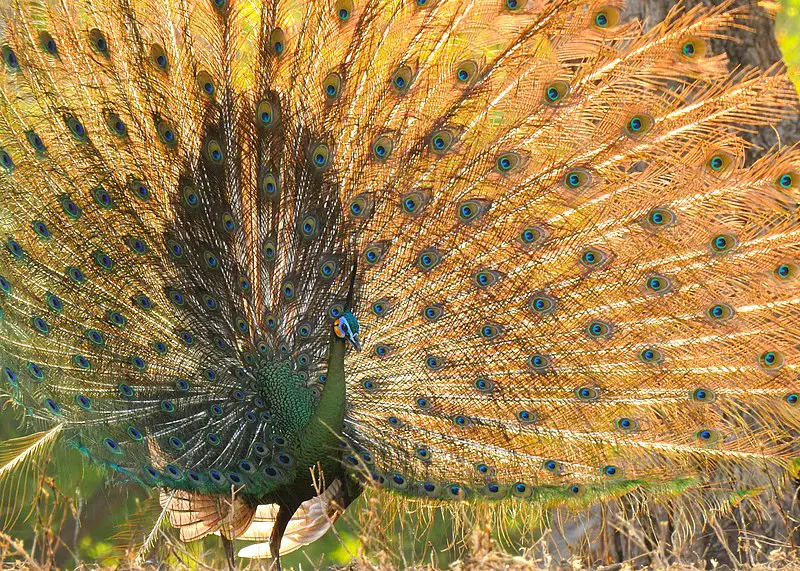
The Green Peafowl is a beautiful bird native to Southeast Asia and Indochina. It has bright green plumage with blue-green neck feathers, which have earned it the name “Indonesian peacock”.
This stunning species of peafowl is Myanmar’s national bird and was once abundant throughout its range. Unfortunately, its population has declined drastically in recent years due to habitat loss and hunting for food.
The few remaining populations are mainly found in Cambodia (mainly northern and eastern provinces) as well as parts of Vietnam.
Due to this drastic decline, the IUCN Red List now classifies the Green Peafowl as endangered. Conservation efforts must be taken soon if we want to save this majestic species from extinction.Scientific classification:
| Kingdom | Animalia |
| Phylum | Chordata |
| Class | Aves |
| Order | Galliformes |
| Family | Phasianidae |
| Genus | Pavo |
| Species | P. muticus |
32. Black-Throated Bushtit
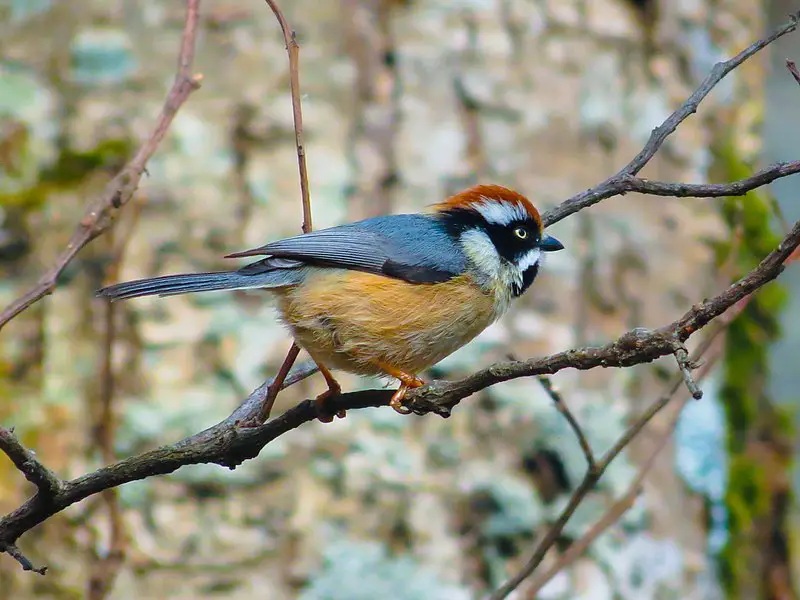
The black-throated bushtit is a small passerine bird found in the family Aegithalidae. It has distinctive markings, with a black throat and pale supercilium on its white head that makes it easy to identify.
Its back, wings and tail are greyish brown while its underparts have yellow tinges. Its size ranges between 10–12 cm long, weighing 6–9 gm as an adult.
These birds inhabit various habitats such as coniferous forests, woodlands and even urban parks where they forage for insects or spiders among foliage or tree bark crevices using their slender bill .
They also feed on fruits like figs when available during winter months especially at higher altitudes across Asia from Afghanistan to eastern China including Pakistan , India , Nepal .
This species often forms large flocks of upto 30 individuals outside breeding season but pairs up during mating period which lasts from February -July depending upon geographic location before migrating southwards towards warmer climates in search of food sources..Scientific classification:
| Kingdom | Animalia |
| Phylum | Chordata |
| Class | Aves |
| Order | Passeriformes |
| Family | Aegithalidae |
| Genus | Aegithalos |
| Species | A. concinnus |
33. Bar-Tailed Treecreeper
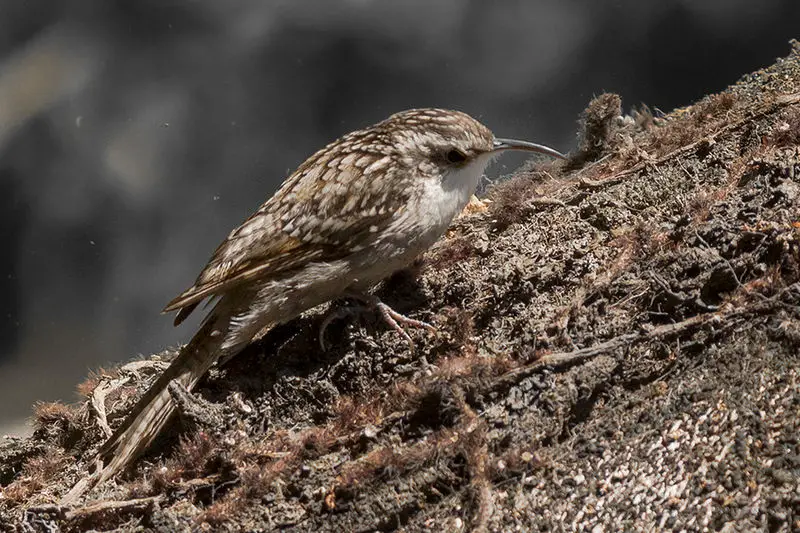
The Bar-tailed Treecreeper is a species of bird found in the northern parts of the Indian subcontinent, including Afghanistan, India, Iran and Nepal.
It has adapted to live mainly in coniferous forests and rocky hillsides at an altitude range from 1000m – 4500m.
Its plumage is generally greyish brown above with white underparts and rufous wings; it also bears a small bill which helps them seek out insects hidden deep within tree bark or cracks.
They are agile climbers who creep up trunks searching for food such as ants and other tiny invertebrates using their long curved claws.
The Himalayan Treecreeper can often be seen clambering around trees during its active hours between dawn till dusk making loud calls that sound like “chick chick”.Scientific classification:
| Kingdom | Animalia |
| Phylum | Chordata |
| Class | Aves |
| Order | Passeriformes |
| Family | Certhiidae |
| Genus | Certhia |
| Species | C. himalayana |
34. Red-Whiskered Bulbul
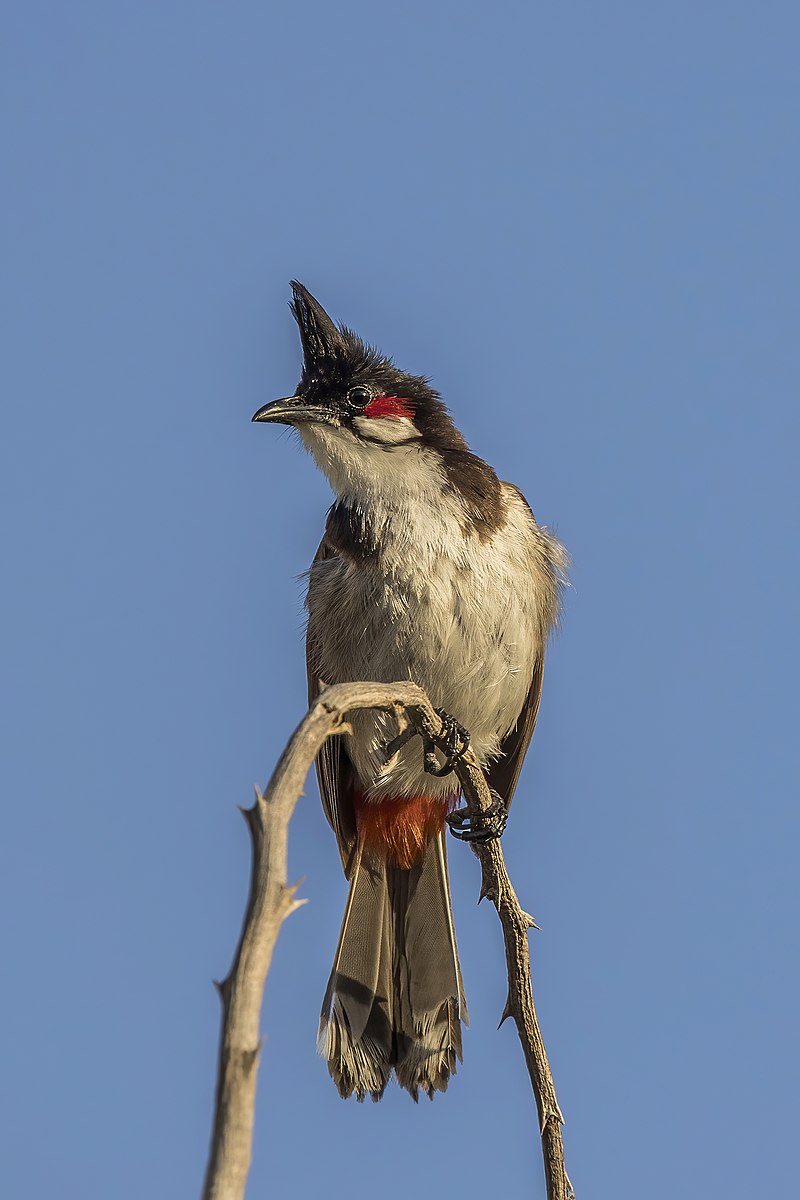
The Red-whiskered Bulbul is a passerine bird native to tropical Asia. It has an unmistakable black head, white cheek patch, and red whiskers on each side of its beak.
This brightly colored bulbul feeds mainly on fruits but also eats small insects from time to time.
The birds are known for their loud call which consists of three or four notes in succession and can often be heard emanating from treetops or other high perches where it likes to sit conspicuously.
Introductions have been made in many parts of the world outside its original range, with populations establishing themselves successfully in various locations including Hawaii and Florida within the United States.Scientific classification:
| Kingdom | Animalia |
| Phylum | Chordata |
| Class | Aves |
| Order | Passeriformes |
| Family | Pycnonotidae |
| Genus | Pycnonotus |
| Species | P. jocosus |
Also Featured In: Hong Kong Birds You Need to See, Common Birds in Kerala
35. Baer’s Pochard
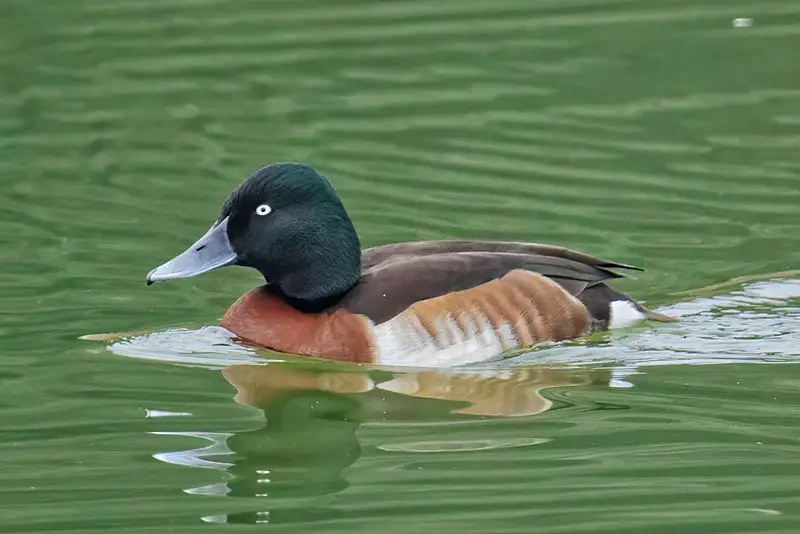
Baer’s pochard is a diving duck endemic to the eastern Asian region. It has an unmistakable black head and neck with green gloss, making it distinct from other species of ducks in the area.
This bird is mostly found in North and Central China but also migrates during winter months to southern China, Vietnam, Japan, and India as well as formerly bred in southeast Russia and Northeast China.
With its monotypic status, there are no subspecies of Baer’s pochard that have been identified yet by ornithologists.
The holotype for this specie was collected near the middle Amur River many years ago prior to its current distribution range being established today.
Its unique appearance makes it easily recognizable among other types of waterfowl inhabiting Asia bringing joy to those who spot them amongst their natural habitats.Scientific classification:
| Kingdom | Animalia |
| Phylum | Chordata |
| Class | Aves |
| Order | Anseriformes |
| Family | Anatidae |
| Genus | Aythya |
| Species | A. baeri |
36. White-Bellied Minivet
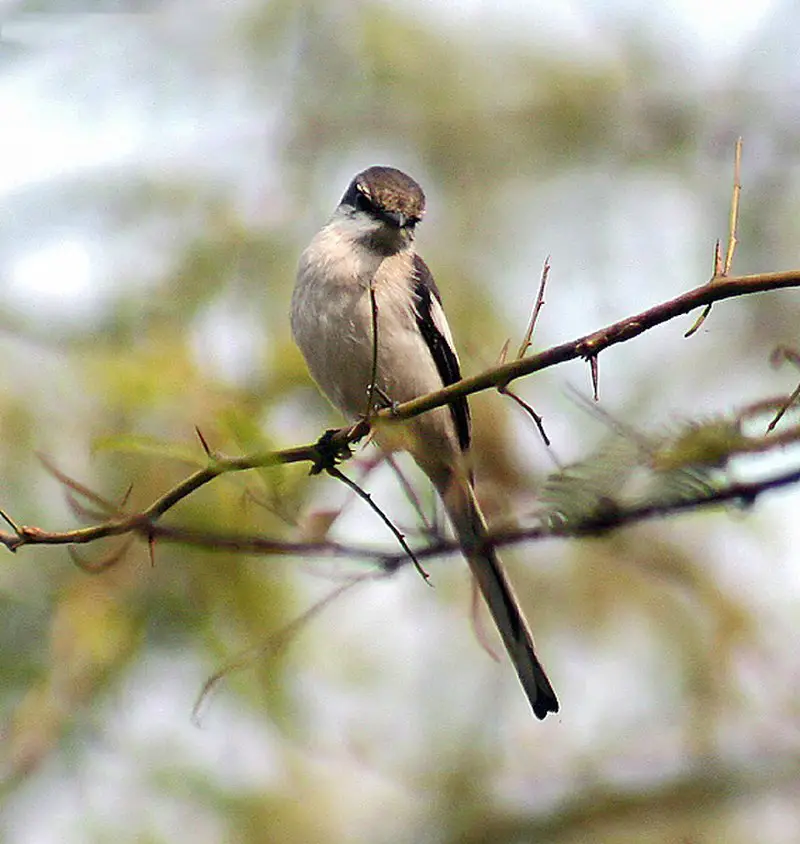
The white-bellied minivet is a species of bird found in Nepal and India, predominantly inhabiting dry deciduous forests.
Its vernacular name seemingly derives from an Indian imitative word associated with its saffron coloring.
The male has a glossy black head, bright yellow cheeks and throat while the rest of its body is mainly white barring some red feathers on the wings; females are slightly duller but also display similar coloration.
They inhabit evergreen forest edges or open habitats such as gardens and fields where they feed on insects by gleaning them off foliage whilst moving through trees.
White-bellied minivets pair up during breeding season to build cup shaped nests out of twigs which they place high up in treetops for protection from predators.Scientific classification:
| Kingdom | Animalia |
| Phylum | Chordata |
| Class | Aves |
| Order | Passeriformes |
| Family | Campephagidae |
| Genus | Pericrocotus |
| Species | P. erythropygius |
37. Greater Adjutant
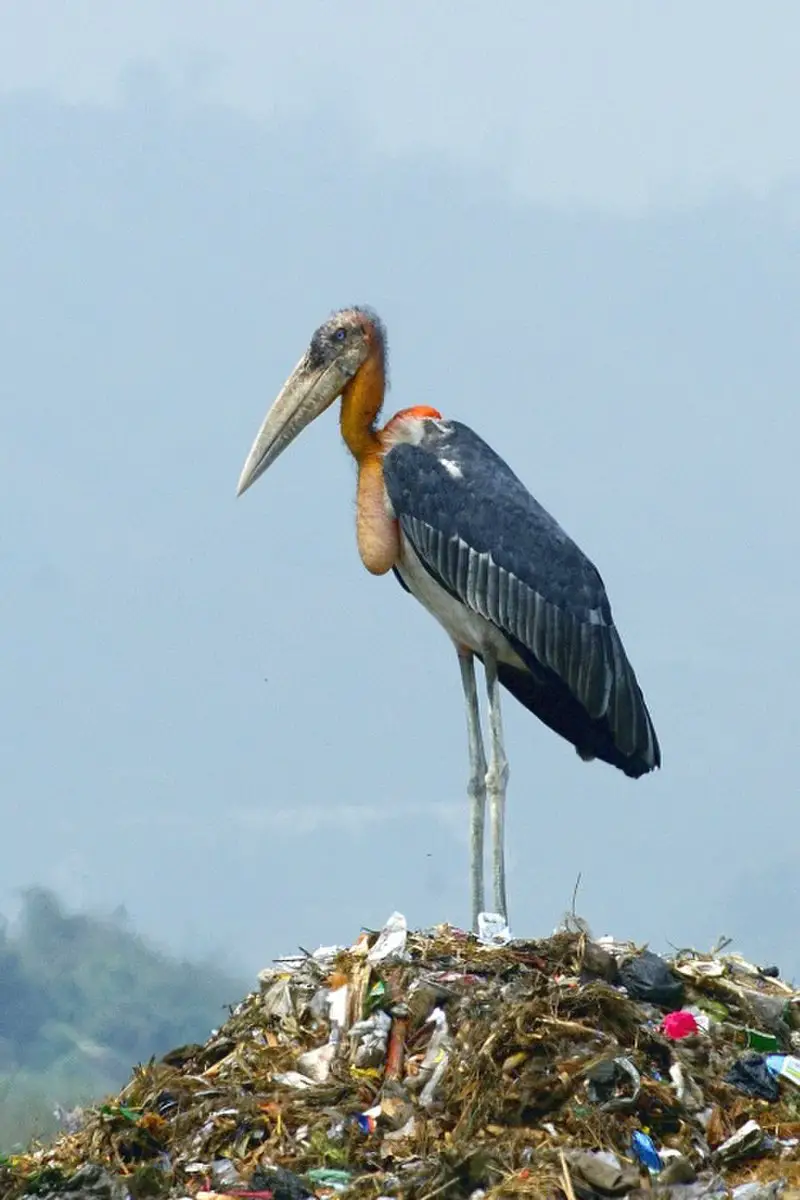
The Greater Adjutant is a majestic member of the stork family, Ciconiidae. It was once found in wide regions across southern and mainland Southeast Asia but now only three breeding populations remain – two in India with the largest colony being located in Assam and another smaller one on an island off Myanmar.
The bird has blackish-grey plumage which stands out against its white shoulder patches giving it a distinctive appearance.
Its large bill gives it an impressive look befitting its size as this species can reach up to 1 metre tall.
Despite their formidable presence, these birds are highly vulnerable due to their small population numbers making them critically endangered.
Conservation efforts such as habitat protection must continue if we are to ensure that future generations will get to admire this beautiful bird for many years yet to come.Scientific classification:
| Kingdom | Animalia |
| Phylum | Chordata |
| Class | Aves |
| Order | Ciconiiformes |
| Family | Ciconiidae |
| Genus | Leptoptilos |
| Species | L. dubius |
Also Featured In: Birds of Karnataka, Common Birds of Jharkhand
38. Pallas’s Fish Eagle
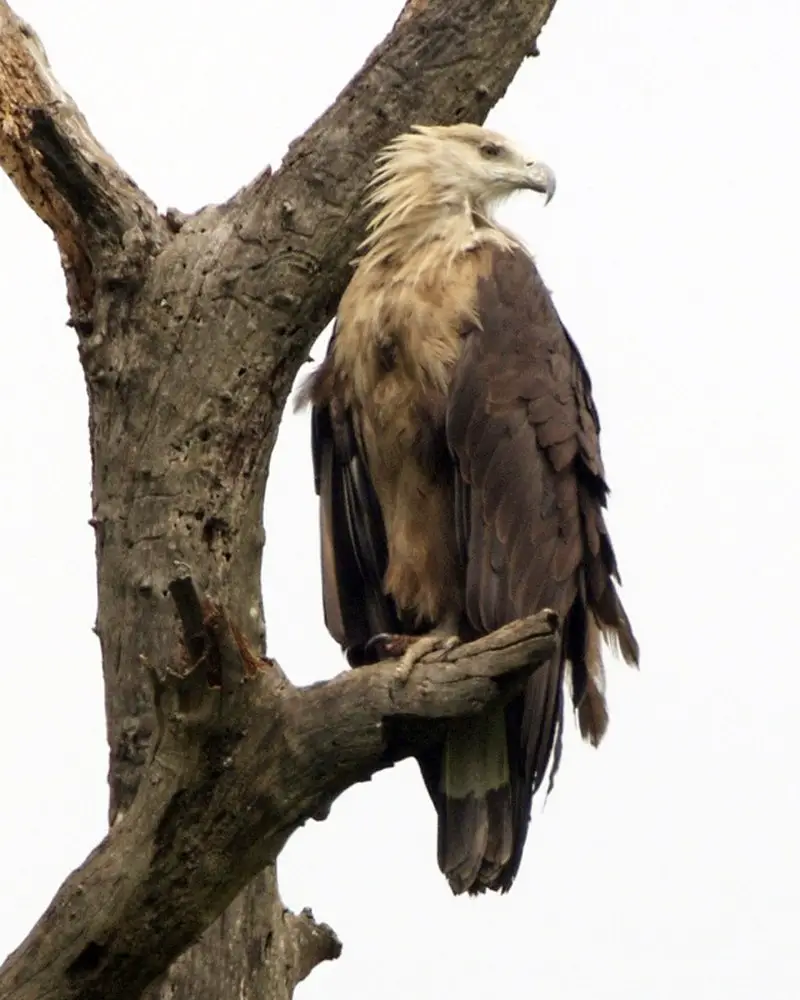
Pallas’s fish eagle is a majestic bird that breeds in east Palearctic. It has a brownish colour and is classified as Endangered on the IUCN Red List due to its decreasing population.
It migrates partially, with Central Asian birds flying south during winter months for food.
This species feeds mainly on fish which it catches near riverbanks or coasts using its sharp talons and powerful wingspan of over six feet.
Although they are difficult to spot due to their elusive nature, Pallas’s Fish Eagle remains an integral part of many ecosystems across Asia where its presence helps keep other populations healthy by controlling the number of fishes available for consumption.Scientific classification:
| Kingdom | Animalia |
| Phylum | Chordata |
| Class | Aves |
| Order | Accipitriformes |
| Family | Accipitridae |
| Genus | Haliaeetus |
| Species | H. leucoryphus |
39. Burmese Bush Lark
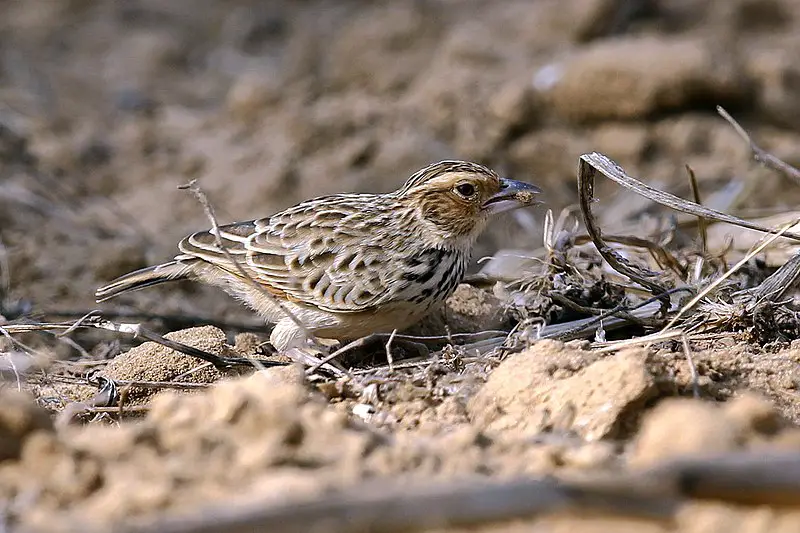
The Burmese bush lark is a species of bird in the Alaudidae family found throughout Southeast Asia. It was once considered a subspecies of the Bengal Bush Lark until it was split following research from Per Alström.
Although its exact global population isn’t known, it’s believed to be plentiful locally. This small songbird has grey-brown feathers and white spots scattered on its wings, with two black stripes running through them.
Its face is pale buff with dark streaks across each cheek, while its throat and crown are golden buff colored. The Burmese bush lark has an incredibly melodic call that can often be heard echoing around the forest canopy during dawn or dusk hours.Scientific classification:
| Kingdom | Animalia |
| Phylum | Chordata |
| Class | Aves |
| Order | Passeriformes |
| Family | Alaudidae |
| Genus | Mirafra |
| Species | M. microptera |
40. Pink-Headed Duck
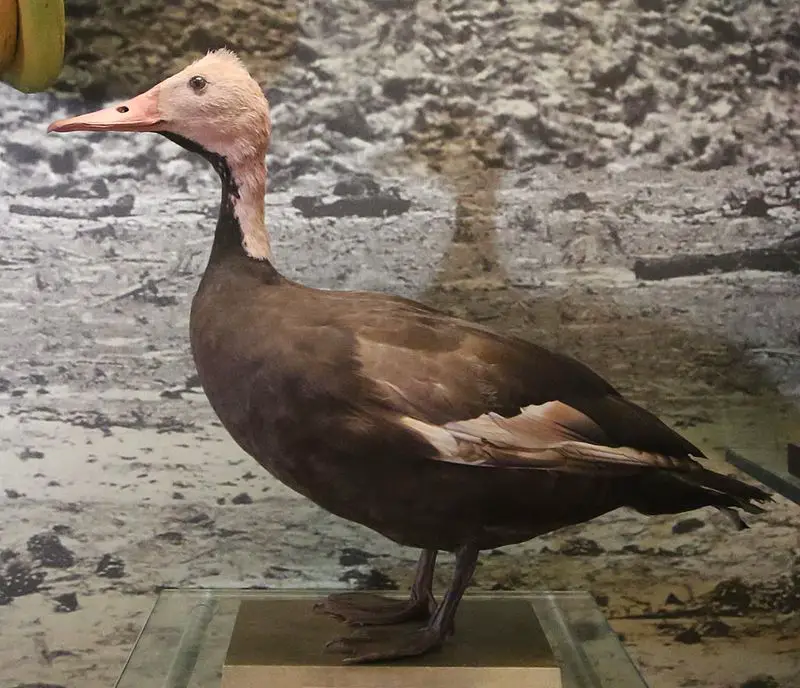
The Pink-headed duck is a large, majestic diving bird that used to inhabit parts of India, Bangladesh and Myanmar. It was believed to have gone extinct in the 1950s due to habitat destruction.
However, there has been no evidence found since then despite numerous searches for it. It’s possible that this species may still exist deep within inaccessible swamp regions in northern Myanmar or southern China.
This beautiful creature had an unmistakable pink head with white cheeks and a dark brown body covered with flecks of white feathers on its wings and tailfeathers.
Sadly, if it hasn’t already vanished from existence altogether we may never get another chance at seeing such beauty in our lifetime again unless urgent steps are taken towards its conservation.Scientific classification:
| Kingdom | Animalia |
| Phylum | Chordata |
| Class | Aves |
| Order | Anseriformes |
| Family | Anatidae |
| Genus | Rhodonessa Reichenbach, 1853 |
| Species | R. caryophyllacea |
41. Edible-Nest Swiftlet
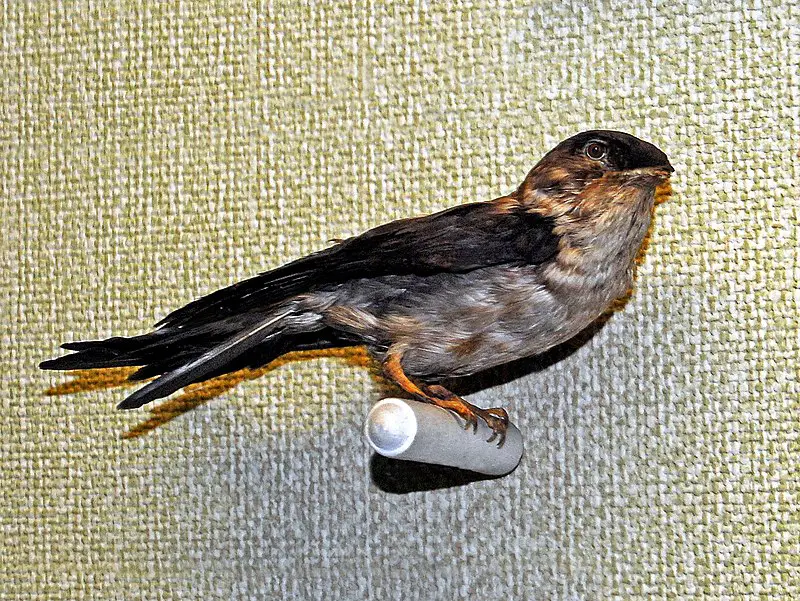
The Edible-nest swiftlet is a small bird found in Southeast Asia, belonging to the Swift family.
It has an opaque and whitish nest which is made of solidified saliva, making it one of its most prized features as it forms the main ingredient for bird’s nest soup – a Chinese delicacy.
Its body length ranges from 14cm (5.5in) and can weigh up to 13g(0.45oz). They feed on insects or flying prey by catching them mid-air with their beaks rather than perching on branches like traditional birds do.
Their nests are usually built in dark corners high above ground level such as caves or gaps between rocks where they lay two eggs at once before hatching them after 18 days incubation period .
The male edible-nest swiftlets also produce special sounds using their wings during courtship season which helps attract females during mating season.Scientific classification:
| Kingdom | Animalia |
| Phylum | Chordata |
| Class | Aves |
| Order | Apodiformes |
| Family | Apodidae |
| Genus | Aerodramus |
| Species | A. fuciphagus |
Also Featured In: Common Birds of Lombok,
42. Crested Serpent Eagle
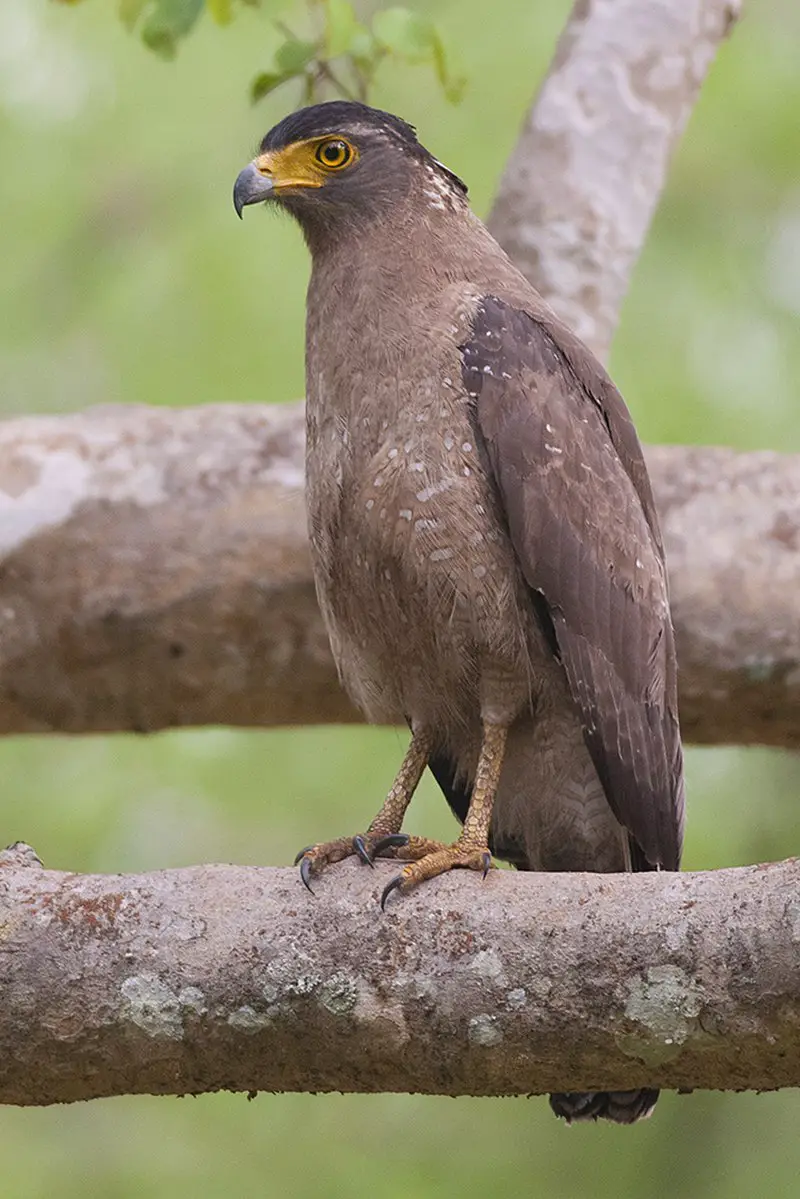
The Crested serpent eagle is a majestic bird of prey found across tropical Asia. With its prominent black and white crest, this medium-sized raptor can be seen soaring above forests in search of food.
It has an extensive range which includes the Indian Subcontinent, Southeast Asia and East Asia; some experts even argue that certain subspecies should be treated as separate species altogether.
This magnificent creature feeds on small animals such as lizards or rodents but will occasionally take larger birds or mammals if it gets the chance.
The Crested serpent eagle remains one of nature’s most impressive creatures to behold.Scientific classification:
| Kingdom | Animalia |
| Phylum | Chordata |
| Class | Aves |
| Order | Accipitriformes |
| Family | Accipitridae |
| Genus | Spilornis |
| Species | S. cheela |
Also Featured In: Common Birds Found near Ishigaki, Ko Mak Birds You Didn’t Know
43. Kalij Pheasant
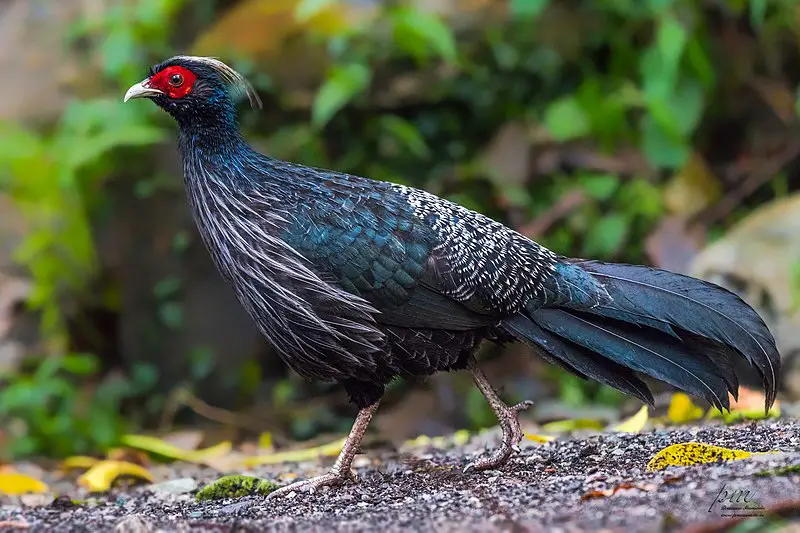
The Kalij Pheasant is a colourful bird found in forests and thickets of the Himalayan foothills, from Pakistan to western Thailand. Males have glossy bluish-black plumage with white markings on their wings, while females are overall brownish.
Both sexes feature a bare red face and grey legs that set them apart from other pheasants. They feed mainly on insects but will also eat seeds and grain when available, making them omnivores by nature.
When courting or displaying aggression towards rivals they create loud vocalisations as well as physical displays such as fluffing up feathers or fanning tails outwards.
These birds live alone during winter months but form pairs for mating season which typically occurs between March – May each year resulting in clutches of eggs being laid shortly after pairing off.Scientific classification:
| Kingdom | Animalia |
| Phylum | Chordata |
| Class | Aves |
| Order | Galliformes |
| Family | Phasianidae |
| Genus | Lophura |
| Species | L. leucomelanos |
44. Grey Peacock-Pheasant
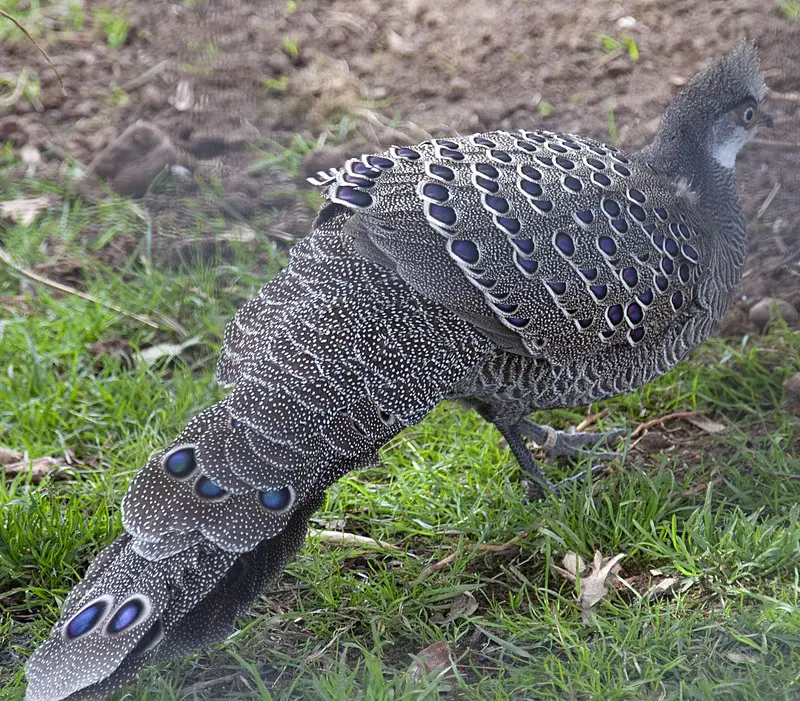
The grey peacock-pheasant, also known as the Burmese peacock-pheasant, is a large galliform bird endemic to Asia. It was first documented by English naturalist George Edwards in 1747 and depicted in his A Natural History of Uncommon Birds with an accompanying description.
The pheasant is grayish brown above with white stripes on its wings while the underparts are black and barred with white speckles; it has two spurs on each leg which gives this species its scientific name bicalcaratum meaning “two spurs”.
This beautiful bird can be seen living near wooded areas or grasslands where they feed mainly on insects and fruits.
Its primary threats include habitat destruction due to human activities such as logging, agricultural expansion, hunting for food or trade purposes.Scientific classification:
| Kingdom | Animalia |
| Phylum | Chordata |
| Class | Aves |
| Order | Galliformes |
| Family | Phasianidae |
| Genus | Polyplectron |
| Species | P. bicalcaratum |
45. Golden-Throated Barbet
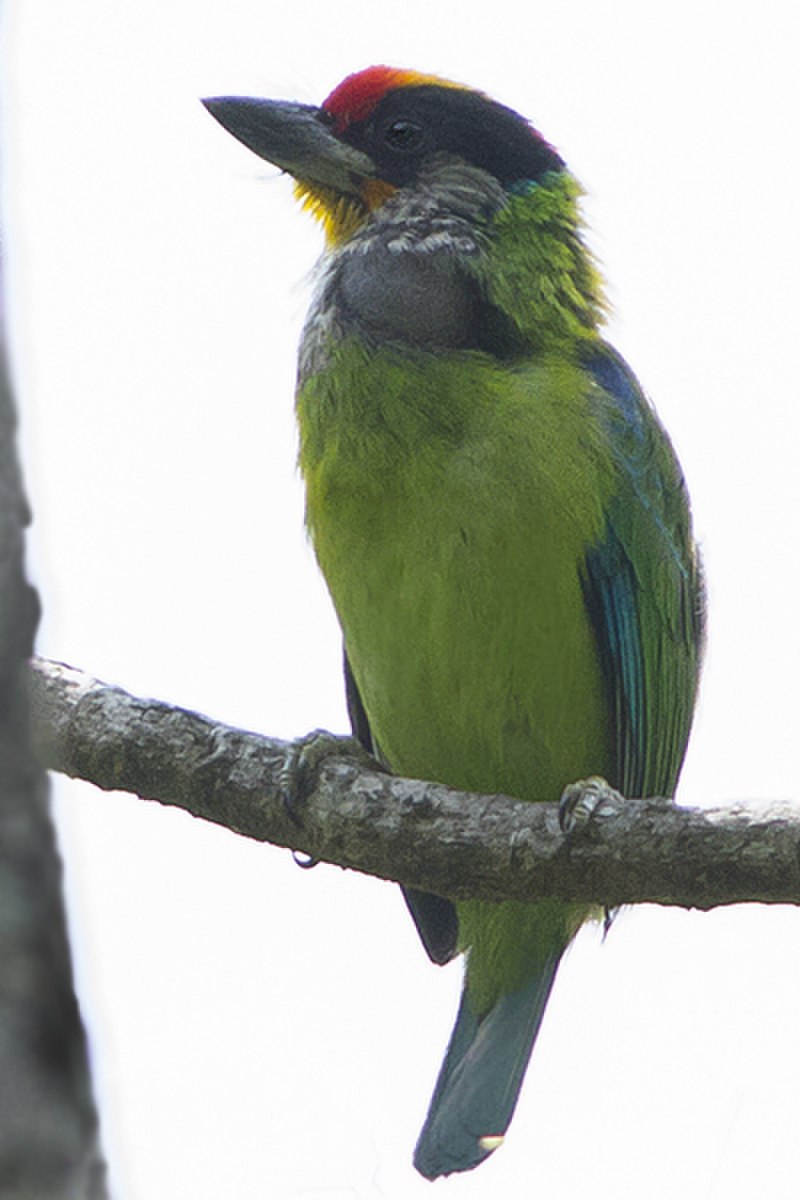
The Golden-throated Barbet is a bird native to Southeast Asia, living in forests between 900 and 2,700 m. It has an eye-catching bright green body with golden throat feathers that give its name.
This species of barbet is listed as Least Concern on the IUCN Red List due to its wide distribution and stable population. First described by Edward Blyth in 1842, this lively bird can be heard singing loudly throughout their range during mating season.
Its diet primarily consists of fruits like figs and insects such as cicadas or caterpillars which it finds while foraging along branches or near trunks of trees.
The Golden-throated Barbet plays an important role in maintaining healthy ecosystems across Southeast Asia through seed dispersal from eating fruit.Scientific classification:
| Kingdom | Animalia |
| Phylum | Chordata |
| Class | Aves |
| Order | Piciformes |
| Family | Megalaimidae |
| Genus | Psilopogon |
| Species | P. franklinii |
46. Silver Pheasant
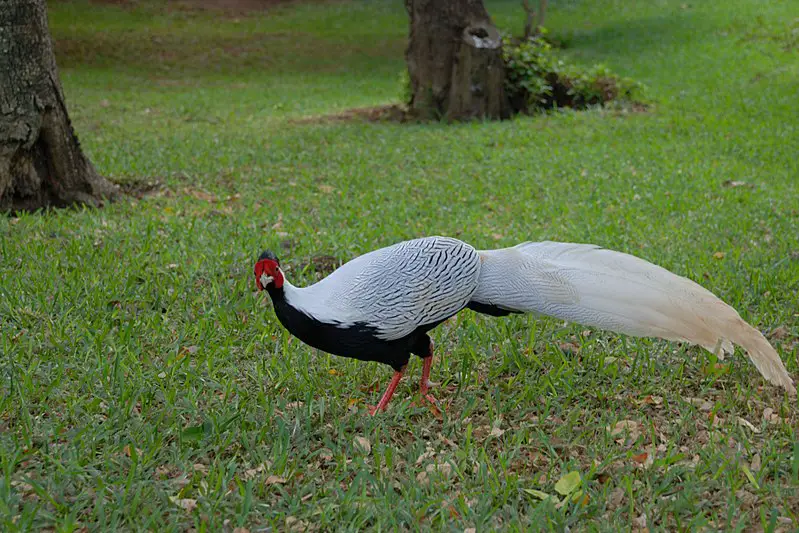
The Silver Pheasant is a stunningly beautiful bird native to parts of Southeast Asia, Eastern and Southern China. This species is known for its distinct black and white feathers in the males, while females are mainly brown.
They both have bare red faces and legs which sets them apart from other birds such as the Golden Pheasant.
The Silver pheasant lives mainly in mountain forests where it feeds on various types of insects, fruits, buds, shoots and seeds.
It has even been introduced to Argentina’s Victoria Island at Nahuel Huapi Lake.
These gorgeous creatures are also popular among aviculture enthusiasts who appreciate their majestic beauty – just be sure to provide plenty of space for these large birds if you hope to keep one as a pet.Scientific classification:
| Kingdom | Animalia |
| Phylum | Chordata |
| Class | Aves |
| Order | Galliformes |
| Family | Phasianidae |
| Genus | Lophura |
| Species | L. nycthemera |